Traveling To The Galapagos
The Galapagos Islands: a remote haven for giant tortoises, blue-footed boobies and marine iguanas. Charles Darwin traveled to the islands in 1835 to study wildlife not found anywhere else in the world. His study of finches led him to develop his theory of evolution and to eventually publish his groundbreaking work On the Origin of Species. As an animal lover, traveling to the Galapagos was always high on my bucket list. It seemed exotic, expensive, and oh so far away. It also felt like a favorite daydream that would never actually happen in real life.
This website participates in the Amazon Services LLC Associates Program. The program enables me to earn a small commission at no extra cost to you if you click through my links and make a purchase at amazon.com and affiliated websites. All opinions of each product are my own. Thank you for your support!

I did a bit of research into the logistics of traveling to the Galapagos, and figured that signing on for a tour would make the most sense for us. We are not normally guided-tour people, but this island chain in the middle of the Pacific seemed to be an exception. I balked, though, after checking out some of the cruise boat tours. Somehow, the thought of boarding a cruise boat in order to go to to a wildlife preserve just didn’t seem to add up. Other travel opportunities popped up for us, and traveling to the Galapagos fell by the wayside.
Then, a local high school biology teacher planned on taking a group of her students to the Galapagos with an organization called EF Travel. Shortly before their scheduled departure date, the teacher tore her Achilles tendon. She regretfully realized that hiking over volcanic landscapes with a boot and a knee scooter was not a practical idea. She asked me to take over as the trip leader, and her misfortune opened an incredible opportunity for David and me.
EF Travel
I had actually looked into EF Travel previously. I didn’t get very far. A chaperone can travel for free with this agency once they have at least six paying students signed up. Unfortunately, I don’t have a lot of connections with teenagers. High school teachers in my area already schedule trips for their students, and principals are reluctant to allow an adult that they don’t know access to their students. I had thrown my name out there, but had always met up with a “Thank you, no.” Then along came the torn tendon.
EF Travel has provided educational tours for students and their teachers for 50 years. They offer trips to far-flung destinations across the globe, including Europe and Asia, Latin America, Australia and New Zealand, and Africa. There are also multiple destinations in the United States and Canada. Signing on with EF Travel was like stepping onto a well-oiled machine. They handle all of the travel arrangements and provide a local tour guide who stays with your group 24/7 once you reach your destination. Check out their website at EF Travel. Trip leaders are responsible for recruiting students and a few informational meetings prior to the trip, and then EF Travel takes over.
Quito, Ecuador
Our group flew into Quito, Ecuador. Located at an altitude of 9,350 feet above sea level, Quito is the second highest capital city in the world. Only La Paz, capitol of Bolivia, is higher. Quito is also the capital city located closest to the equator. I felt a twinge of deja vu as our plane approached the city. The movie Proof of Life, starring Meg Ryan and Russell Crowe, was filmed here, and due to the movie the view from the plane was vaguely familiar to me. Our tour director met us at the airport, and accompanied us to our hotel. We spent our first day touring the highlights of Quito, including Independence Plaza, the Colonial Quarter, the National Basilica and the Santo Domingo Monastery.
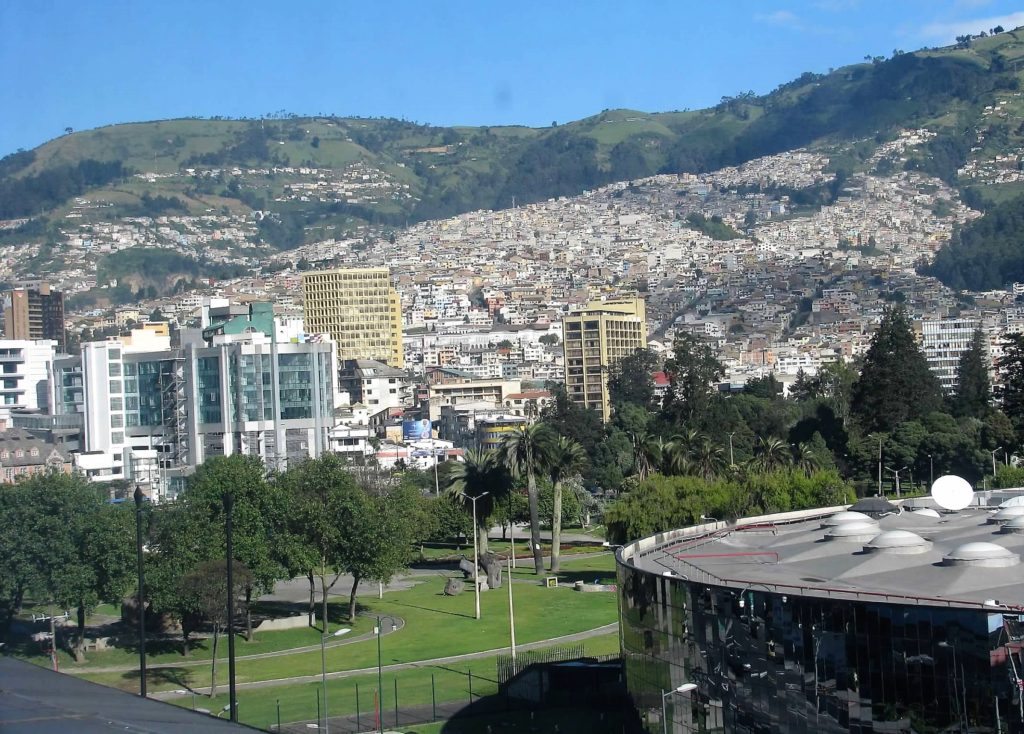

On the morning that we were to fly to the Galapagos, we had to meet in the hotel lobby at 3:30 am. Ugh! We were given a ham and cheese sandwich for breakfast, along with a juice box and a piece of fruit. We flew from Quito to Guayaquil, and the in-flight meal was another ham and cheese sandwich. We then took a small plane 560 miles off of Ecuador’s Pacific coast to the island of Baltra, where they gave us – wait for it – a ham and cheese sandwich! I had eaten three ham and cheese sandwiches by 10:30 in the morning.
Isabela Island
We then took a ferry from Baltra to the island Isabela. We were driven to a hacienda for lunch, where we were amazed to see giant tortoises feeding nearby. I had not expected to see them so close to people, but the huge reptiles seemed unfazed by our presence.
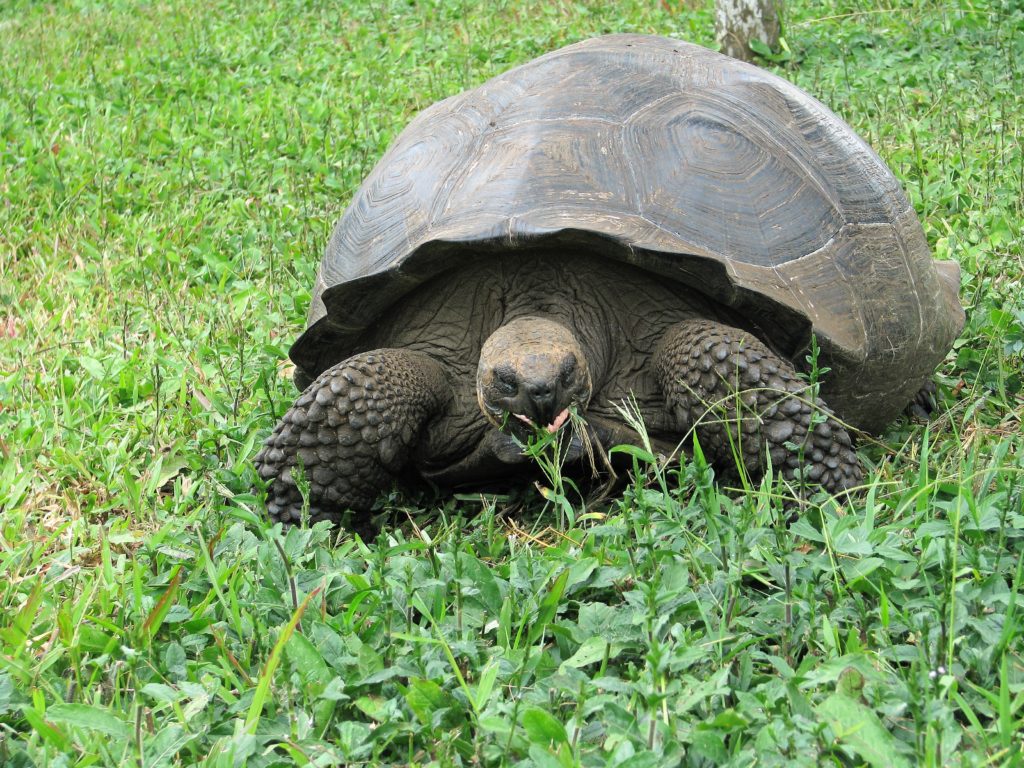
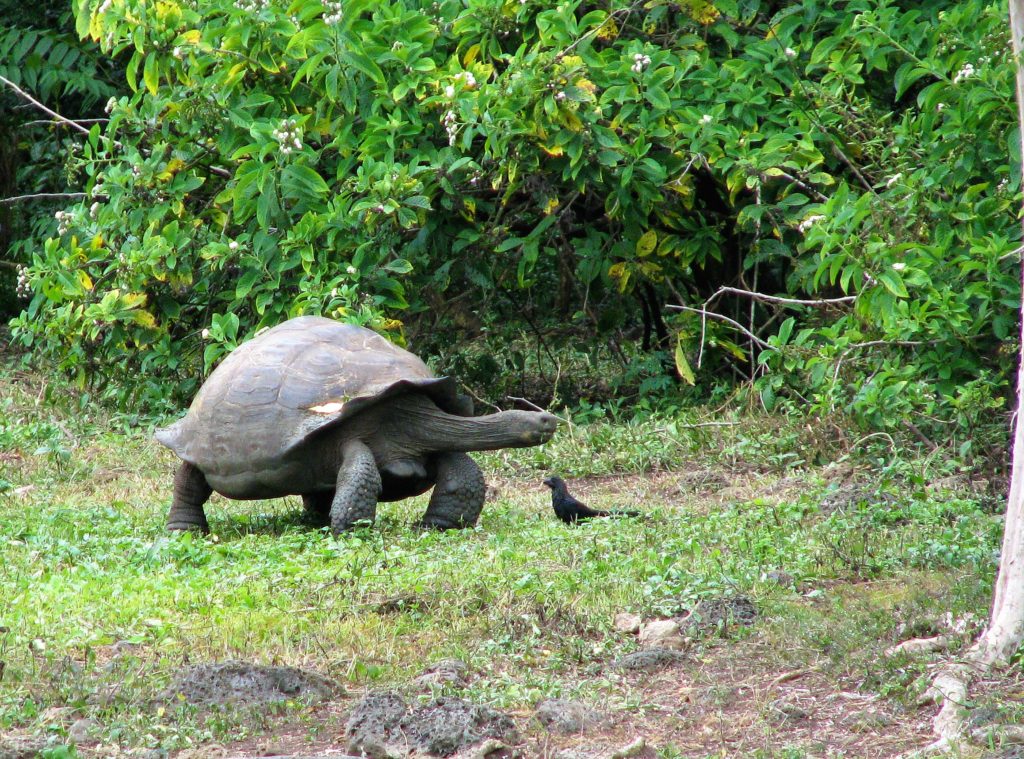
We checked into the El Paraiso Hotel and had some time to explore the volcanic beach before a rainstorm set in. We caught our first glimpses of the iguanas and crabs that seemed to be everywhere we went on the islands. The volcanic rock formations were fascinating, (and a bit tricky to navigate on) and I often found myself staring into shallow pools of water amid the rocky outcroppings. I was taken aback to see a face staring back up at me. One of the local people informed me that it was actually a moray eel!
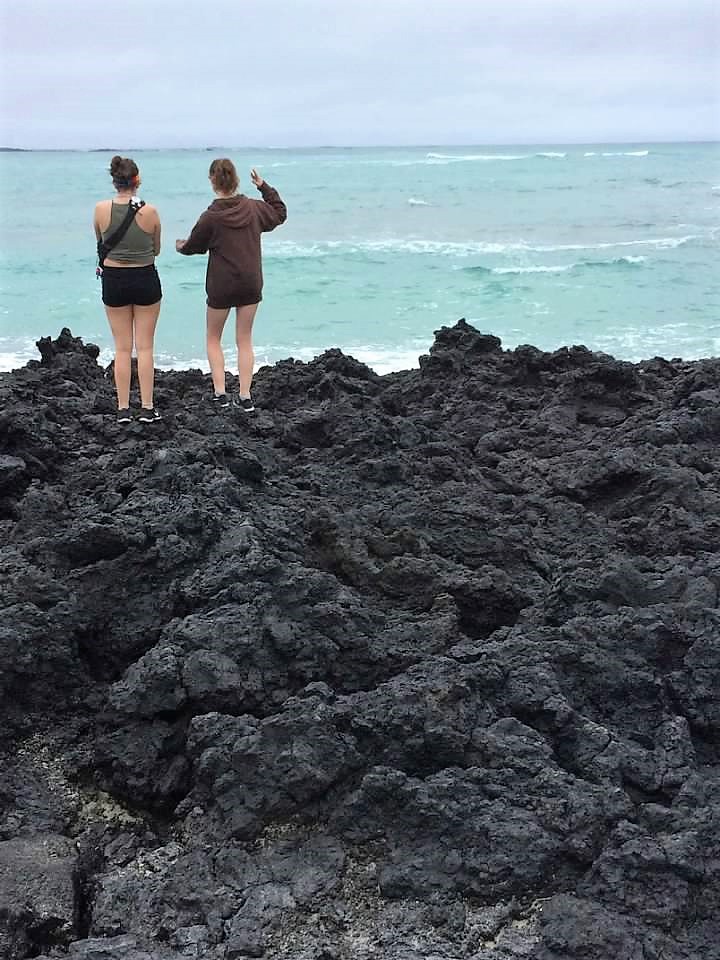

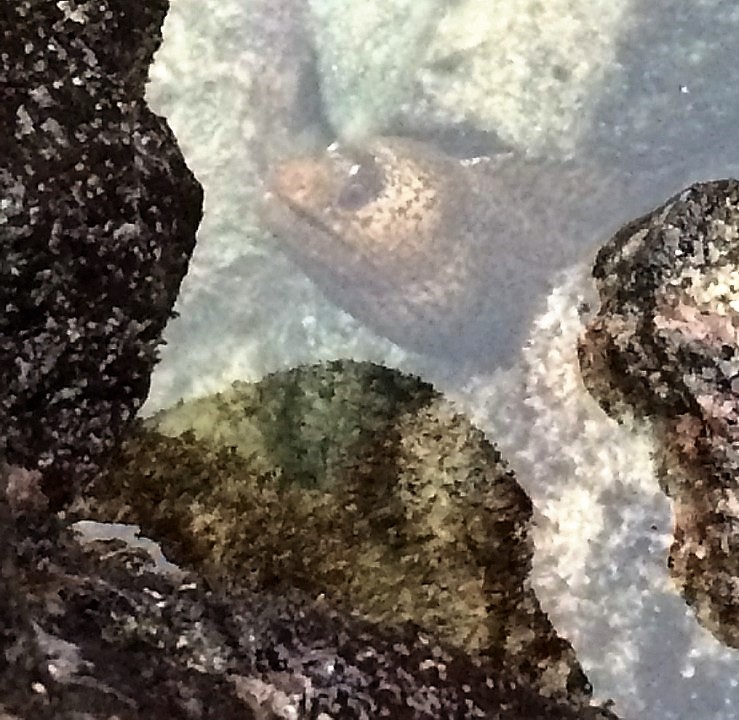
We had to get up early the next morning (apparently a standard occurrence with EF Travel) and were surprised to find there was no running water when we tried to jump into the shower. Insider tip: Many hotels in the Galapagos turn the water off between 11:00 pm and 6:00 am.
We hopped onto another boat and headed for the far side of Isabela Island. The sea between islands can actually be quite rough, and more than one of our group member made good use of the sea sickness sacks! Luckily, neither David or I are prone to sea sickness. I always headed for the top deck of the inner-island boats when ever possible, preferring to get soaked with spray rather than be bounced around below deck.
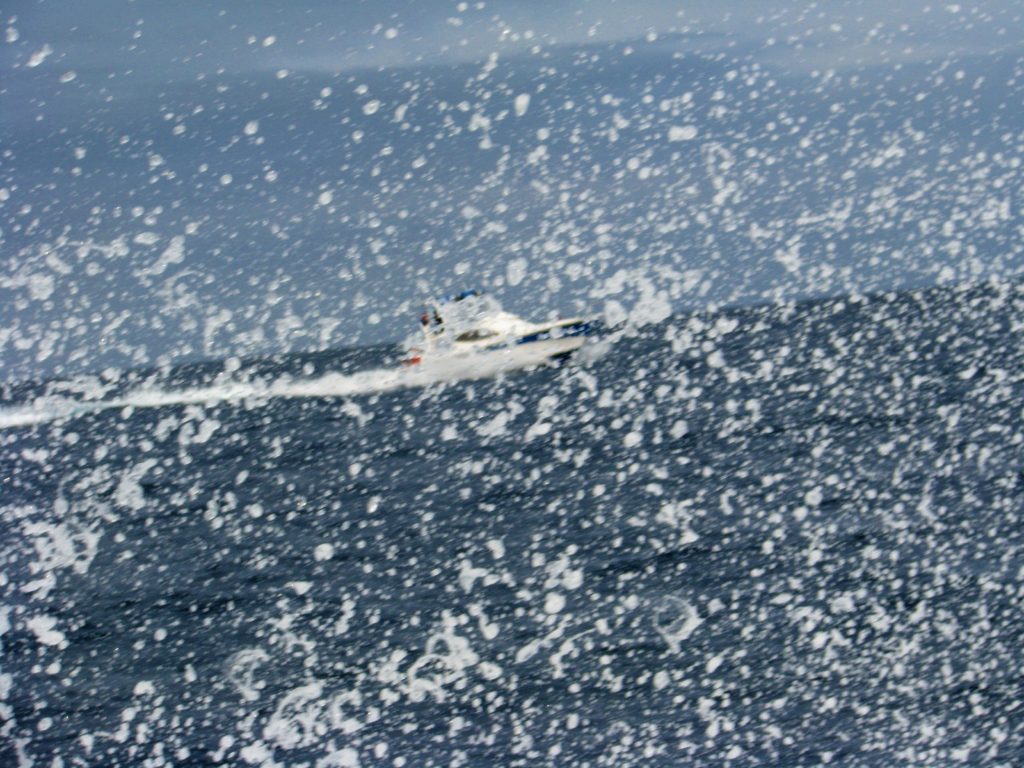
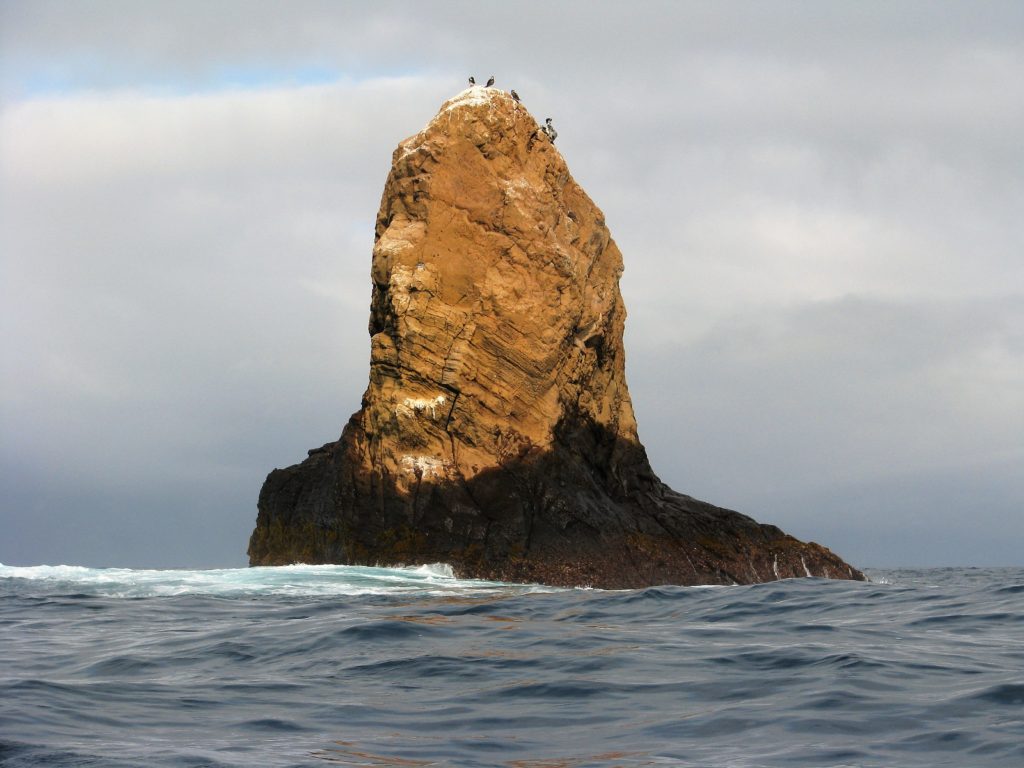
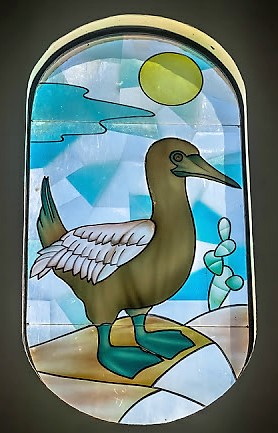
We stayed in Puerto Villamil, a small port village on the southeastern edge of Isabela. As we walked through town, we were delighted to discover a magnificent statue of Saint Francis of Assisi gracing the exterior of St Anthony’s Church. It was the first time we had seen a church with stained glass windows featuring a blue footed booby, an iguana and a penguin! The interior of the church is decorated with images of the indigenous animal life on the island. We especially loved Jesus ascending up over the beach, and the giant tortoise under the table!
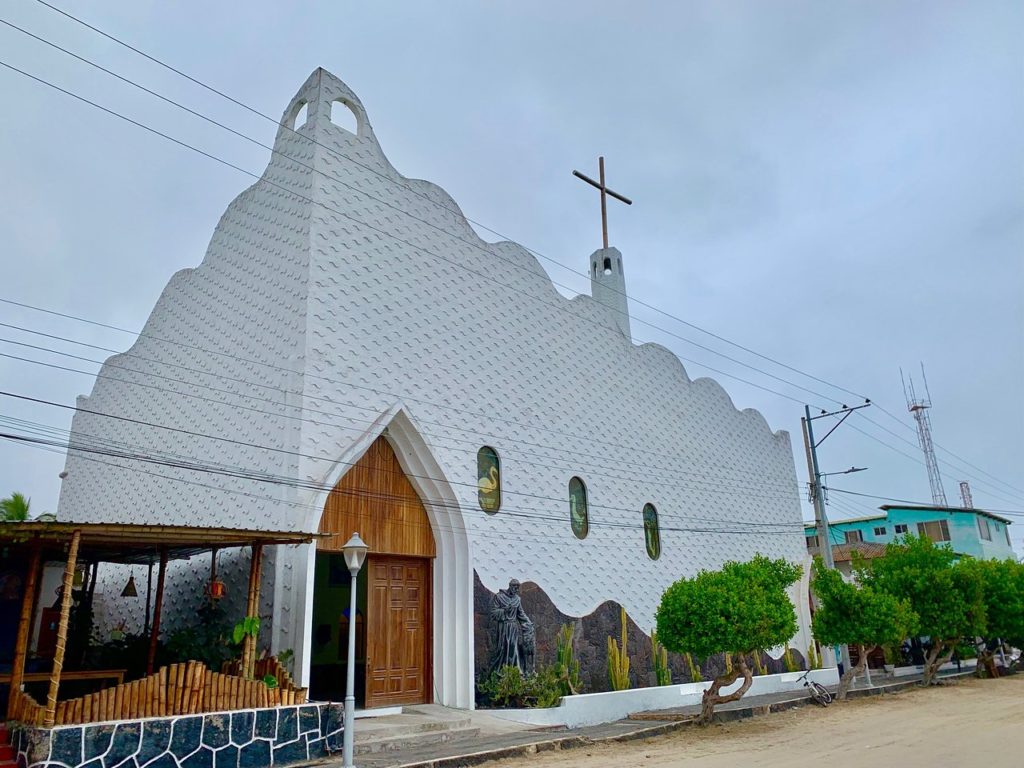
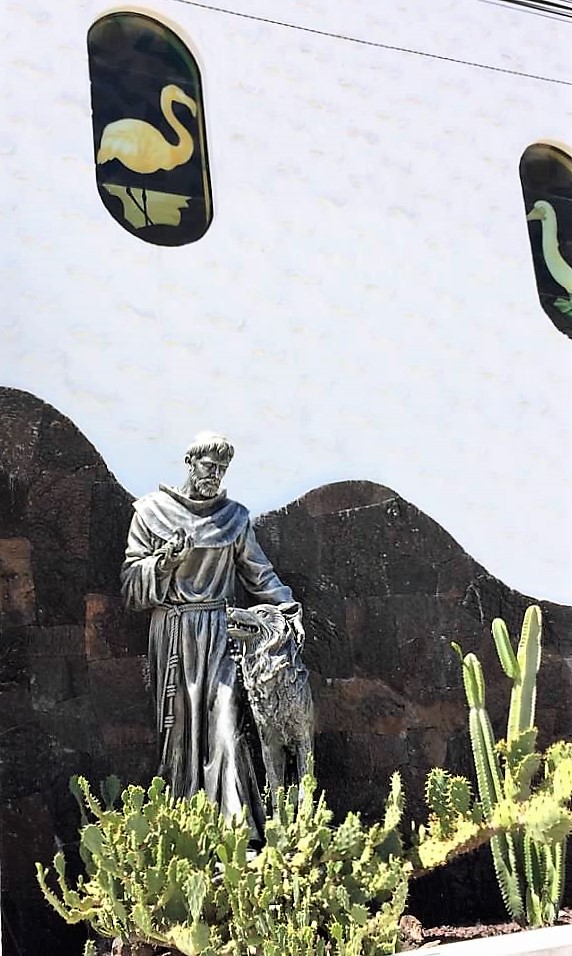
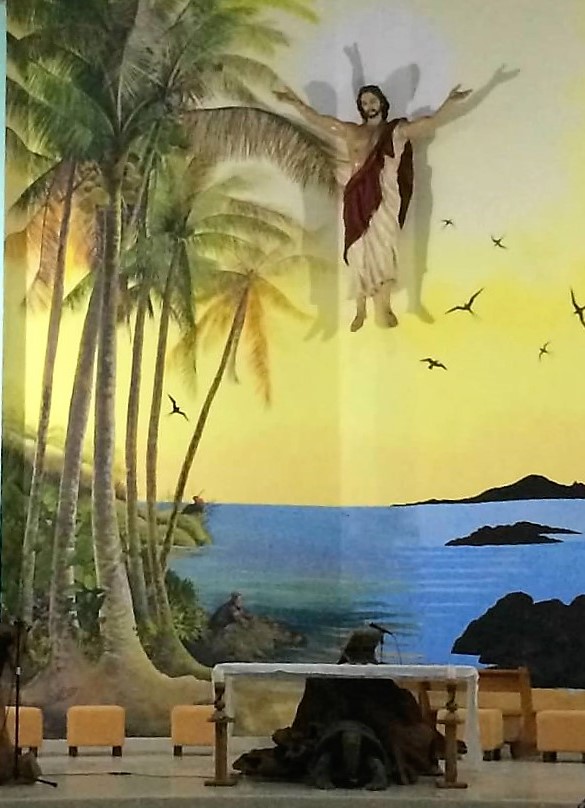
While hiking around the water on Isabela, we were able to observe many of the creatures that the Galapagos Islands are famous for, including the iconic blue-footed booby. Blue-footed boobies have an elaborate mating dance which prominently displays their blue feet. Apparently, the male with the bluest feet is highly attractive to a female.
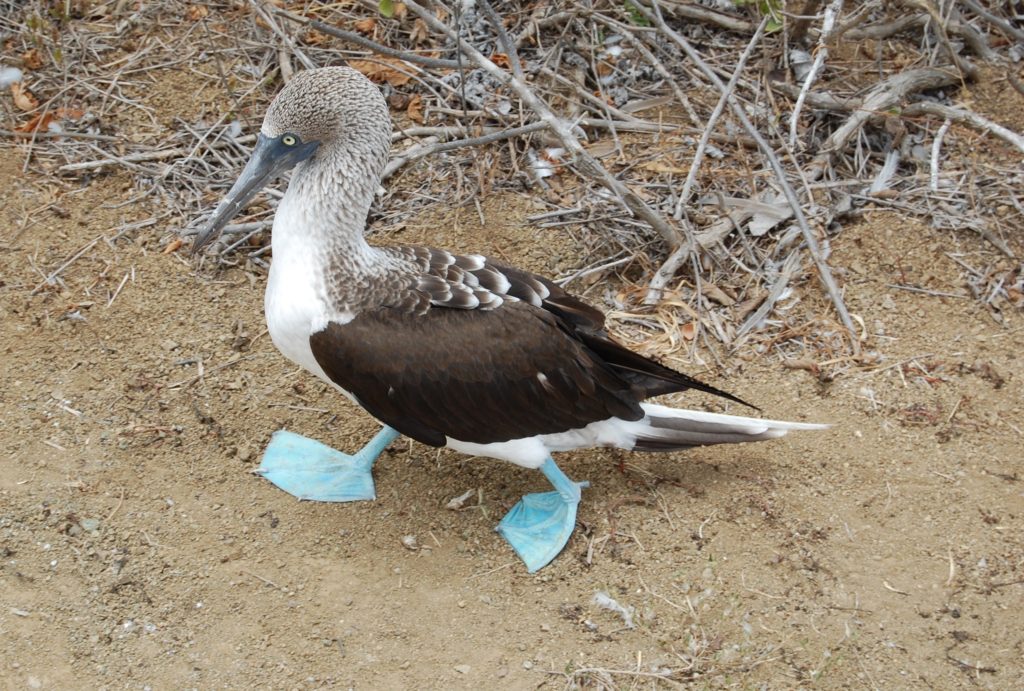
There were ample opportunities to observe the Galapagos’s famous marine iguanas, the only lizards on Earth that swim in the ocean in search of food. They were completely unimpressed by our little group and there were plenty of times when we had to move off of a trail to avoid stepping on one. Marine iguanas feed on underwater seaweed and algae. These lizards have fearsome looking claws for clinging onto rocks both underwater and on the shore.
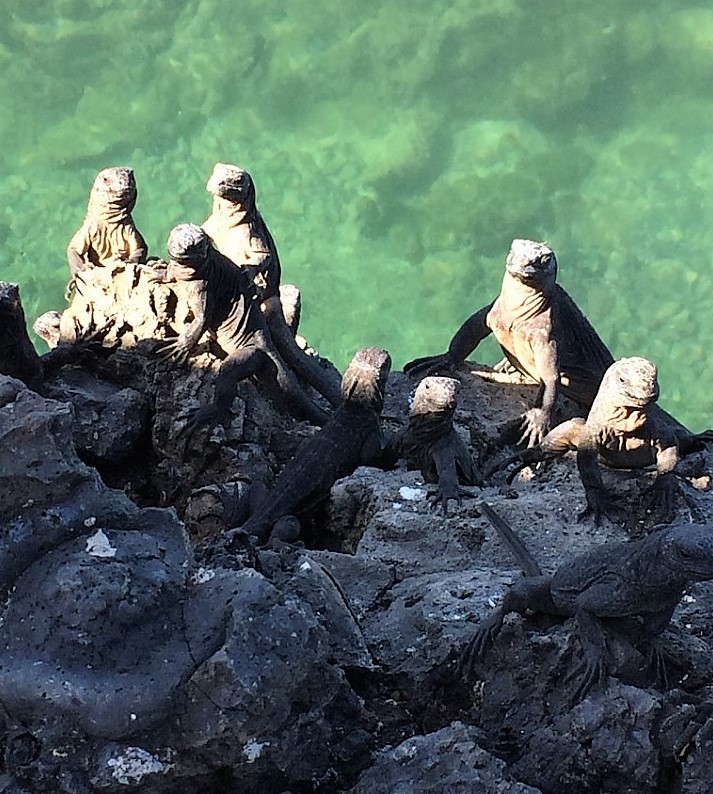
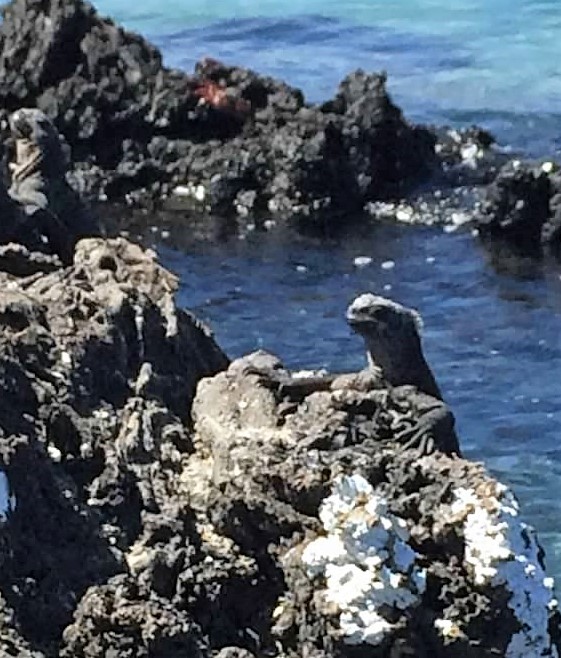
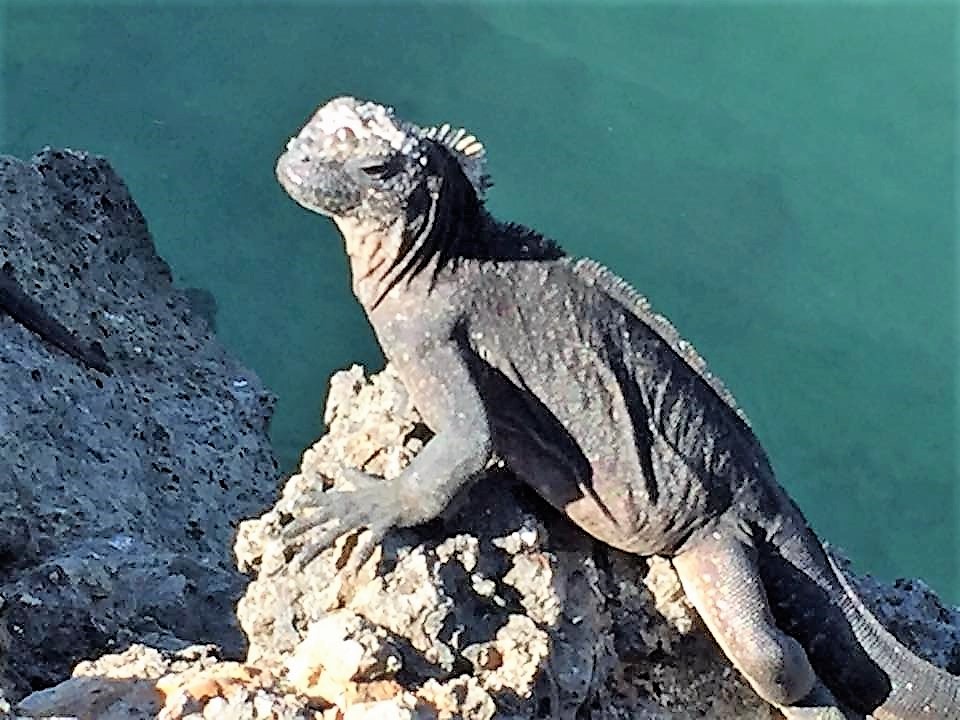
The rocky shoreline was teeming with crabs that are an incredibly bright red color. The crabs are extremely fast and agile, as they have 10 legs that enable them to move rapidly in four different directions. Apparently camouflage is not a concern when a creature has a remarkable ability to outmaneuver any predator! Called the Sally Lightfoot crab, these seemed to be the only creatures in the Galapagos that were extremely skittish around people. While we saw them everywhere, it was hard to get a good photo of one. Locals say that the crab was named after an infamous Caribbean dancer for the way it dances among the rocks.

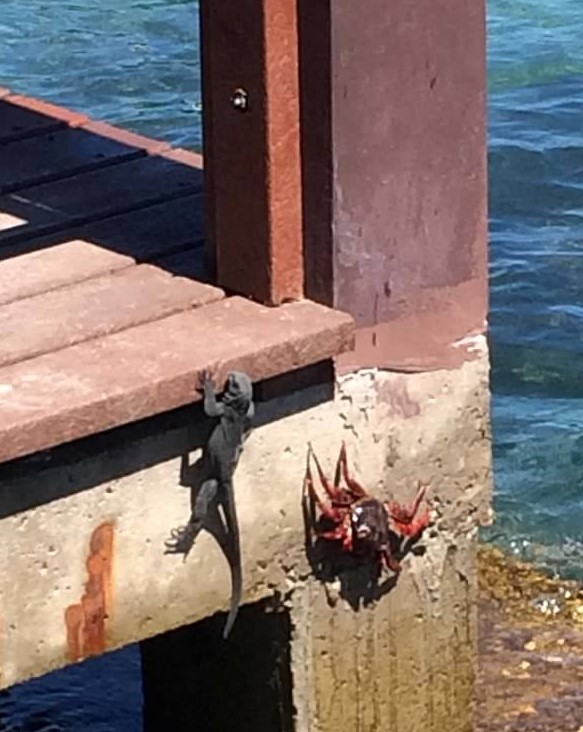
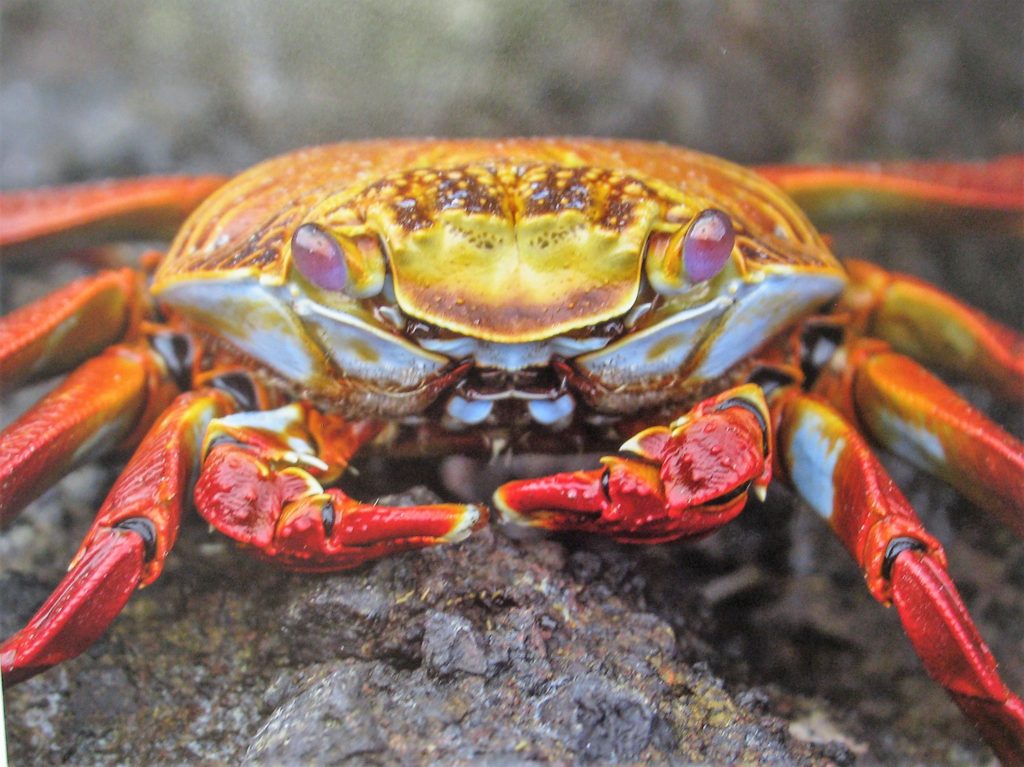
We saw an abundance of sea birds in the area, including the Galapagos Penguin. This is the only type of penguin that can be found north of the equator. They nest in caves and crevices in volcanic rock. White tip reef sharks rested in the shallow waters.
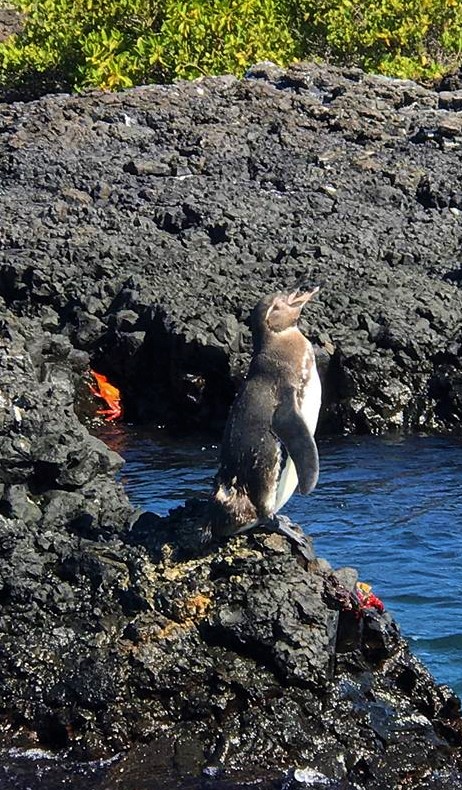
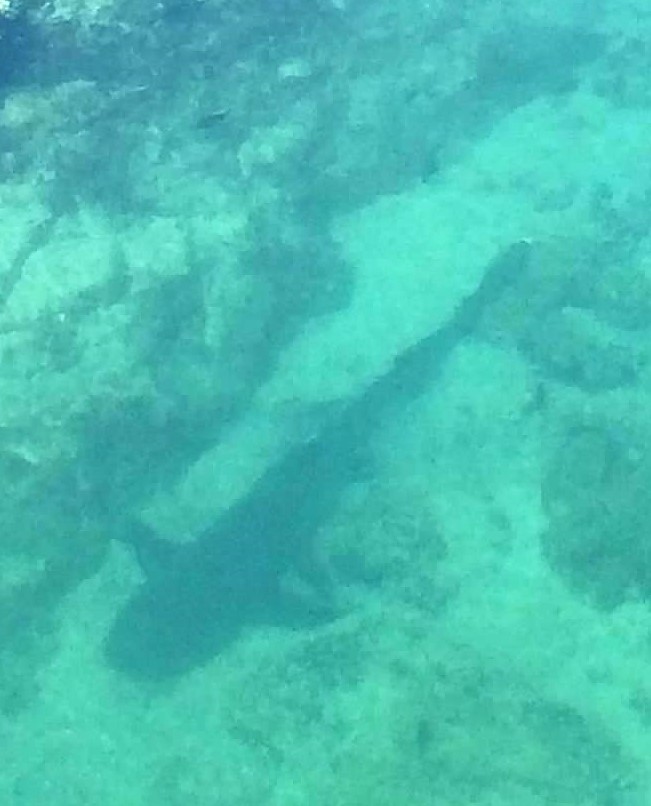
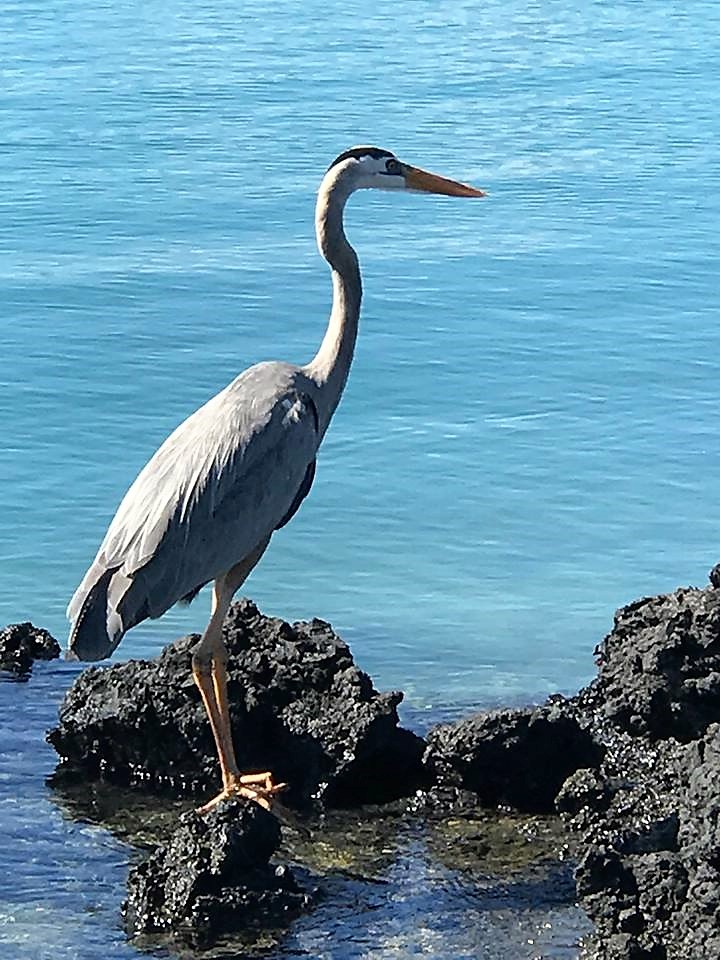
Cueva de Sucre
The next morning, we had plans to hike up the Sierra Negra volcano for a scenic view. But when we awoke, the mountain tops were cloaked in fog. Our guide came up with Plan B: a visit to the Cueva de Sucre. (sweet cave) It is actually a lava tube, formed after a volcanic eruption, when lava on the surface of the ground cooled and hardened quickly. The molten lava underneath slowly drained away, leaving a hollow space below the hillside. When we first saw the small hole that was the entrance to the cave, it was hard to believe that our group would be able to fit inside. There are actually stone steps built down from the lip of the cave. There was plenty of room in the chamber below for our group to move around comfortably. Our guide asked everyone to extinguish their flashlights for a moment, and it is an intense sensation to be standing in complete and utter darkness. All sorts of roots were growing down through the ceiling, which was covered with interesting formations. We thought they were stalactites, but our guide explained that they were in fact small lava tubes formed as the molten lava cooled and hardened.
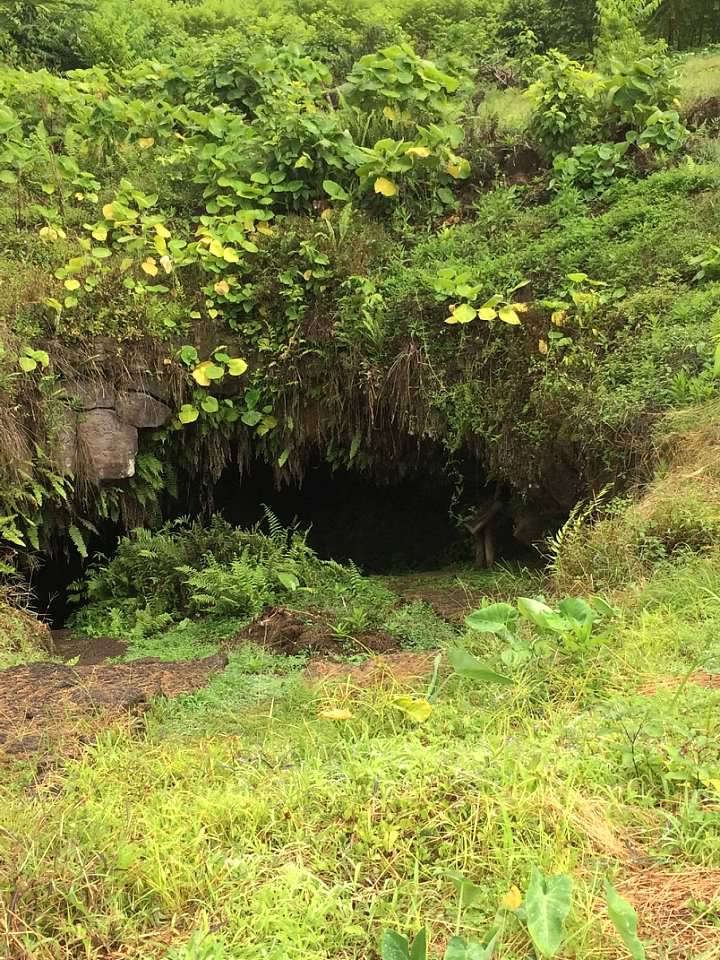
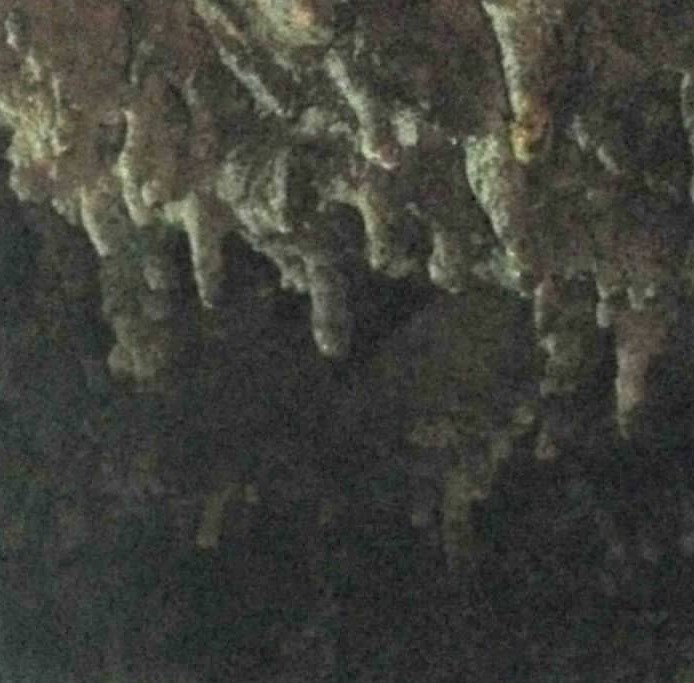
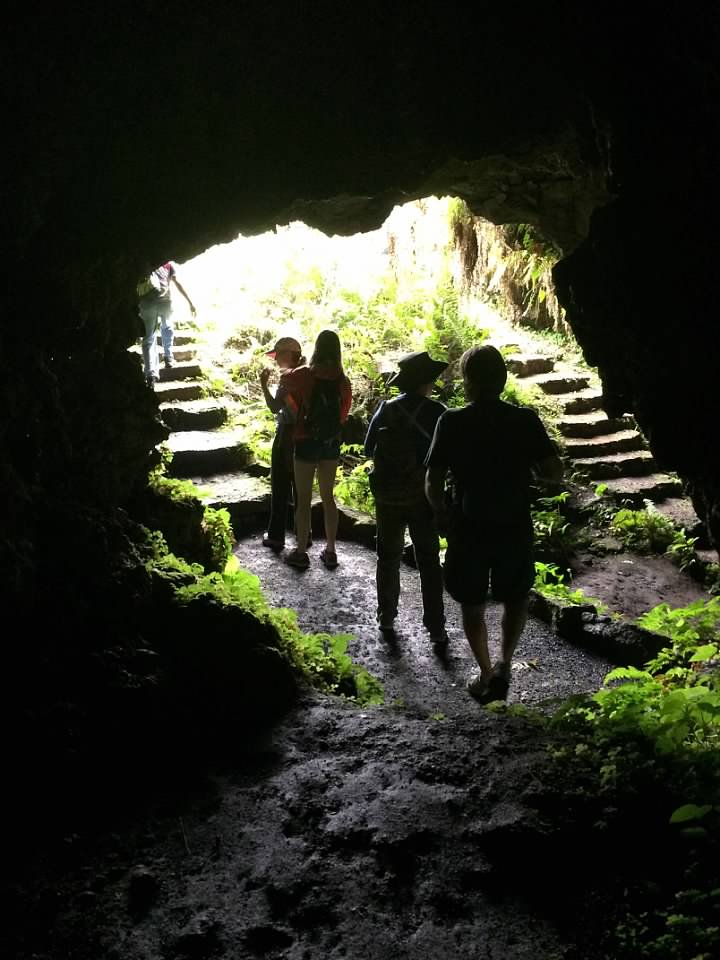
We stopped at lagoon to watch flamingos stirring up the mud with their feet as they searched for food. According to our guide, these flamingos are among the pinkest in the world, due to the salinity of the water and the small crustaceans that they feed on.
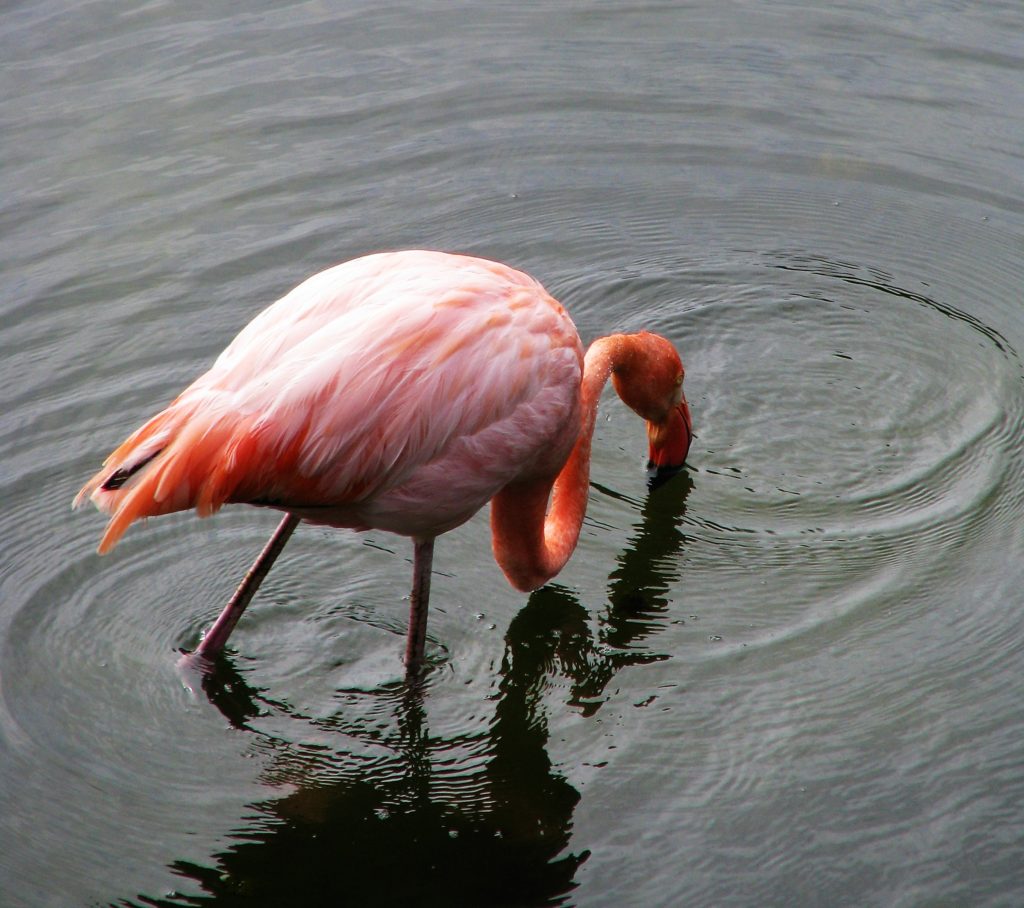
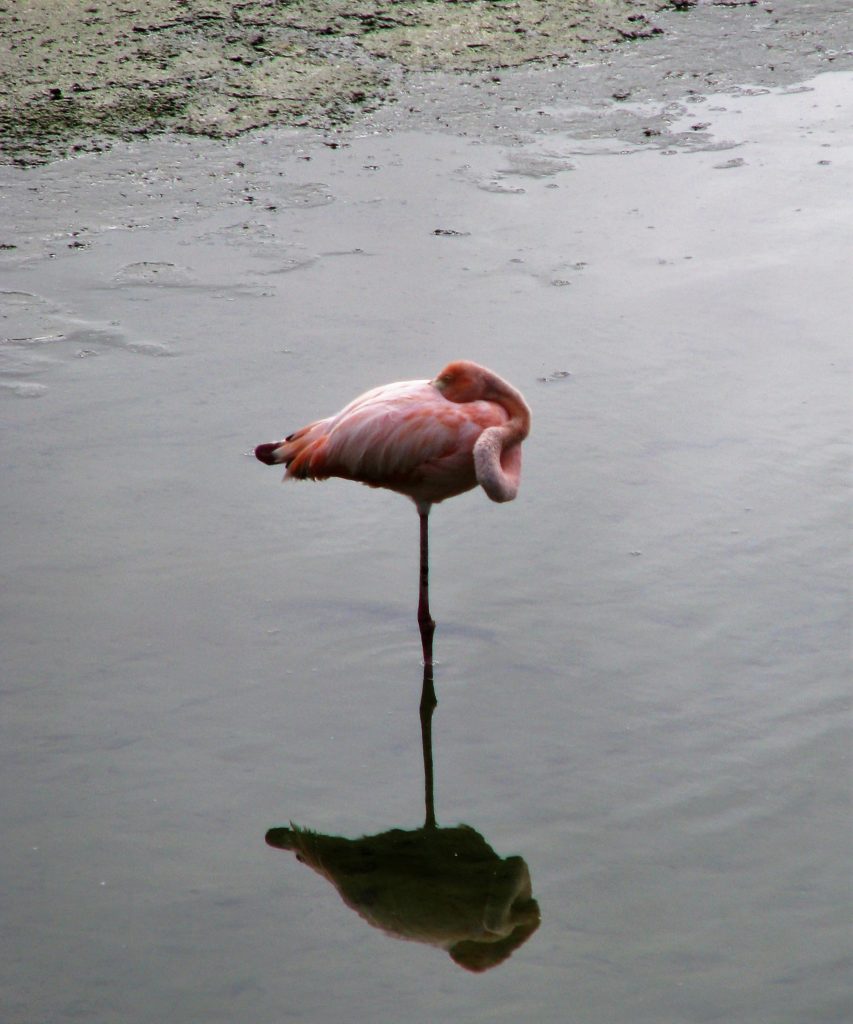
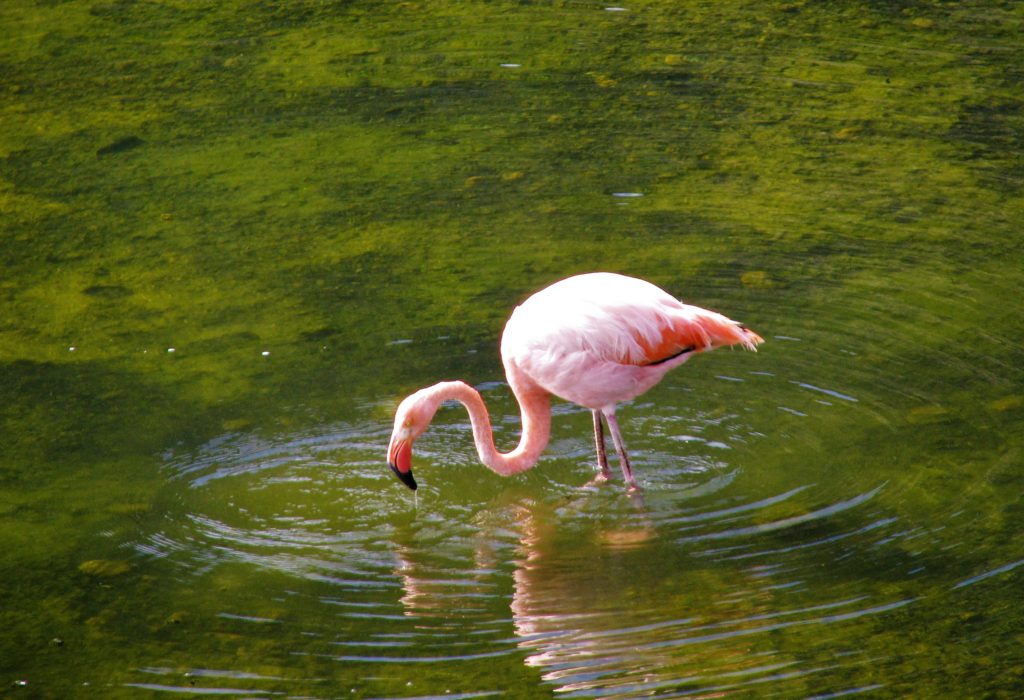
Santa Cruz Island
Day 4 found us back on Santa Cruz Island after another excruciatingly early morning boat ride. We hadn’t even made it off of the dock when we saw a sign asking people to keep their distance from the sea lions. We couldn’t help but wonder how this particular sea lion was persuaded to take a snooze in this precise location.
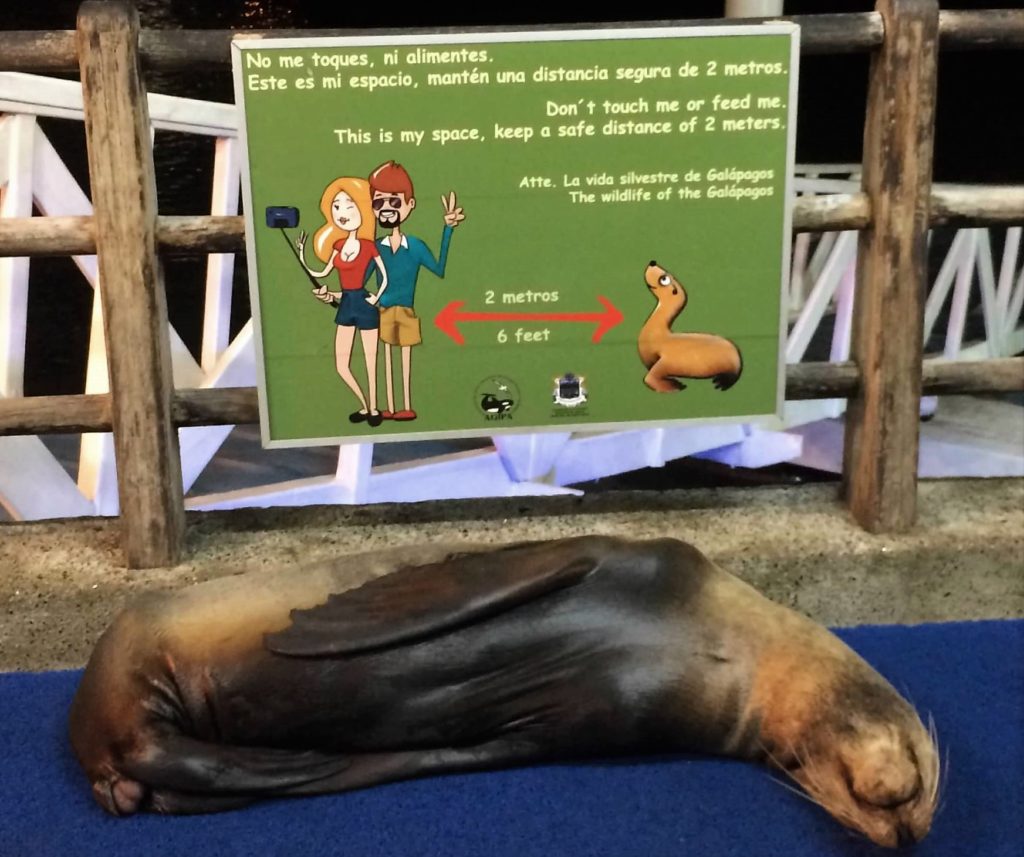
When we checked into the Hotel Deja Vue I was relieved to learn that each room is equipped with a safe. As a trip leader, I was responsible for collecting money from all of the participants to tip our daily guides throughout the week and our tour director on our last night. It was a sizable amount of cash and I never felt completely comfortable carrying it around. Sadly, my relief at discovering the safe was short-lived.

Charles Darwin Research Station
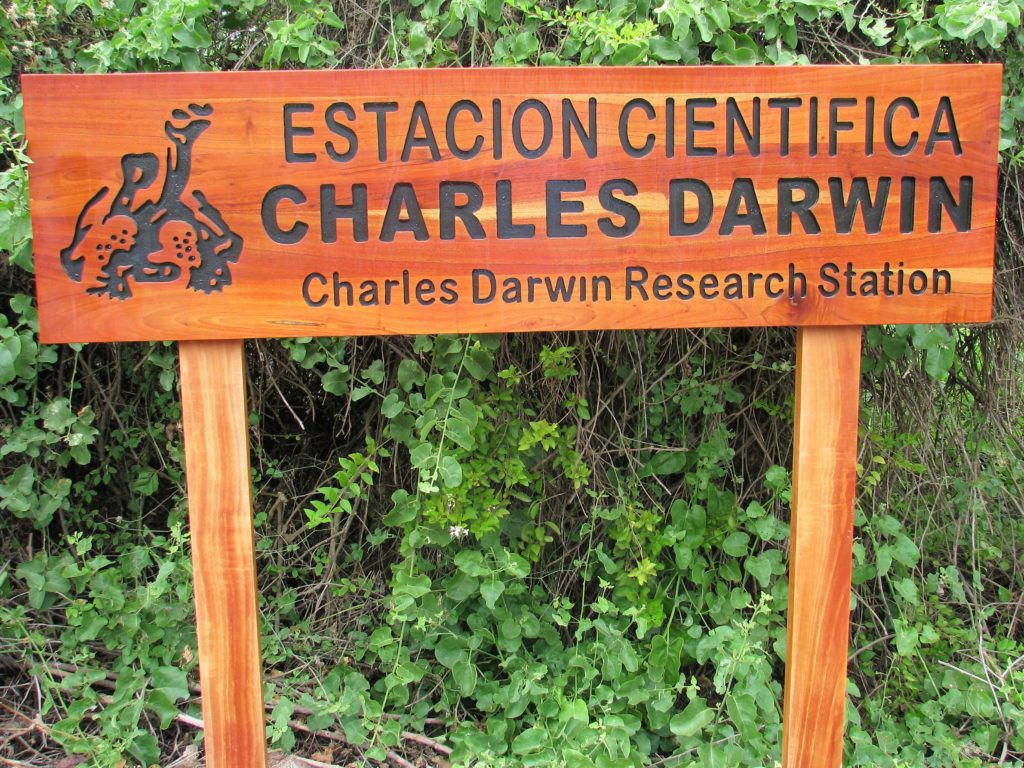
An absolute highlight of our trip: a visit to the Charles Darwin Research Station. The Station’s mission is to conduct ongoing research in order to ensure the conservation and biodiversity of the Galapagos Islands. At the time of our visit, there were a number of study projects going on, including marine conservation, land-bird research, and exploring ways to rid the Islands of invasive species. The visitor center and exhibits detail Charles Darwin’s observations of finches while formulating his theory of evolution and the process he called natural selection.
My favorite part of the visit was touring the Galapagos giant tortoise breeding program. Adult tortoises were first brought to the Research Station to breed when it was discovered that virtually all baby tortoises were being killed by black rats that had inadvertently been introduced to the islands. In nature, the tortoises mate in November and December, and then the females migrate away from the males to the lowlands to nest. In captivity, the males and females are not separated and the animals breed all year. And no, the presence of visitors does not deter them!
Tortoise eggs are also collected from nests throughout the islands and are brought to the breeding center to hatch in safety. Incubation of the eggs lasts 120 days. The young hatchlings spend their first two years in protected pens. Once they are 5 years old, the juveniles are returned to their island of origin.
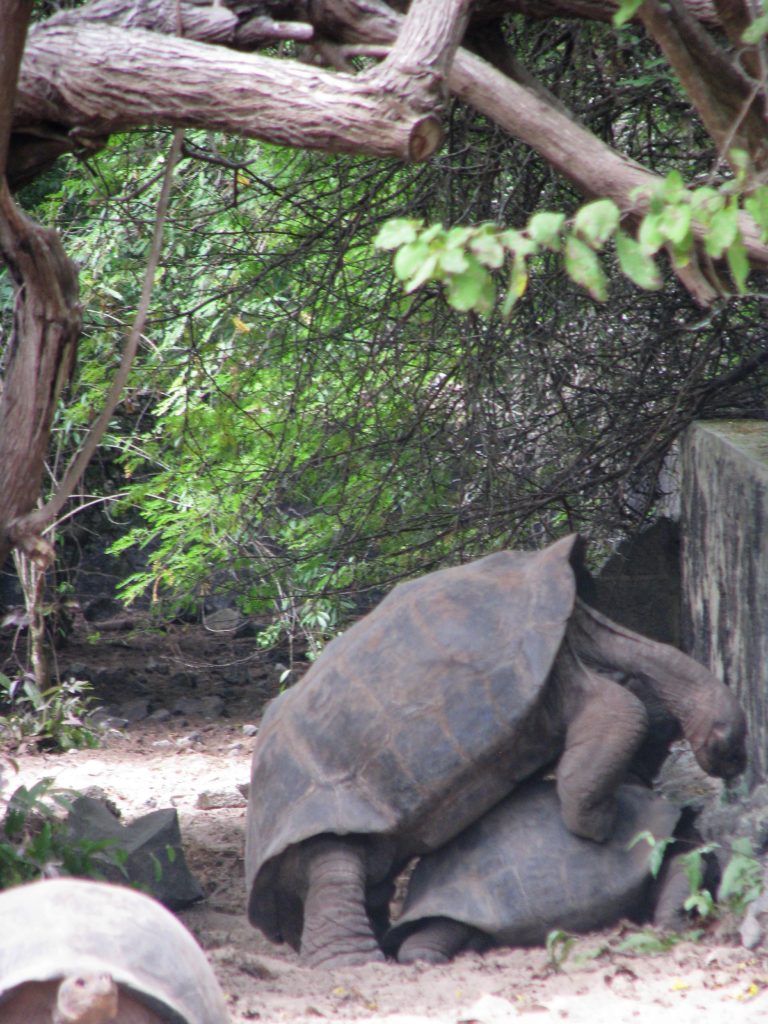
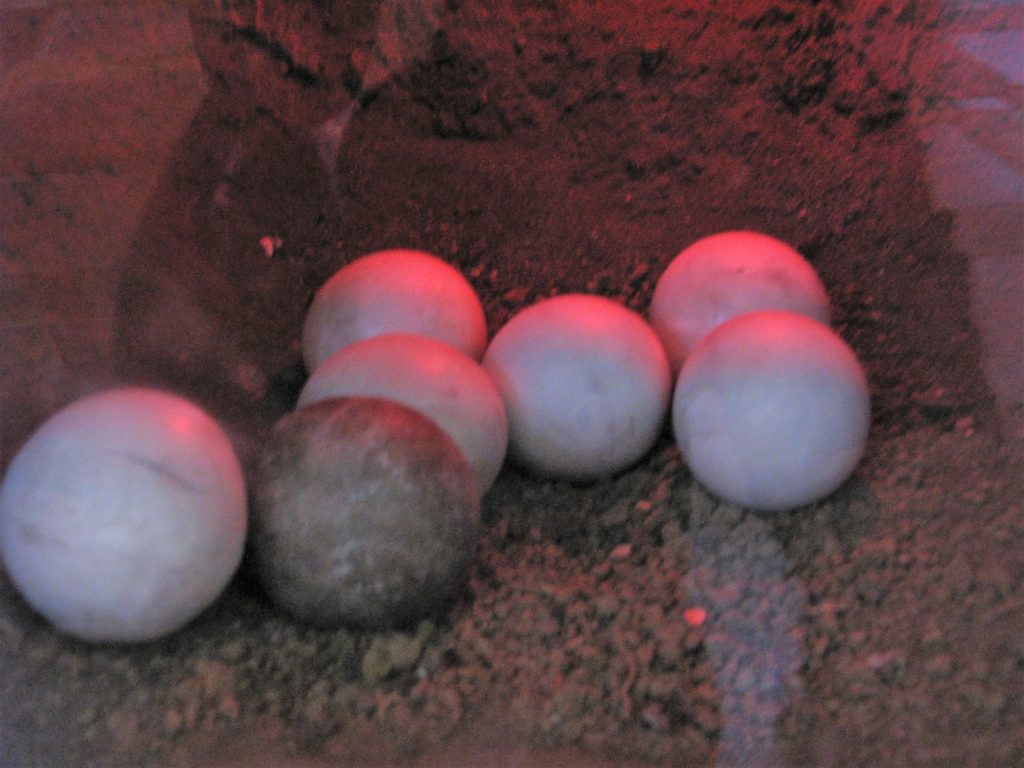

One small tortoise fell off of a step and landed on its back. We were about to look for an attendant for help, when we noticed another youngster coming over to check him out. The second tortoise then made its way to a cluster of others and somehow communicated with them. They all rushed over (as much as a tortoise can rush) and worked together to nudge the first one right side up . We were so blown away by this display of cooperation that I neglected to get a photo!
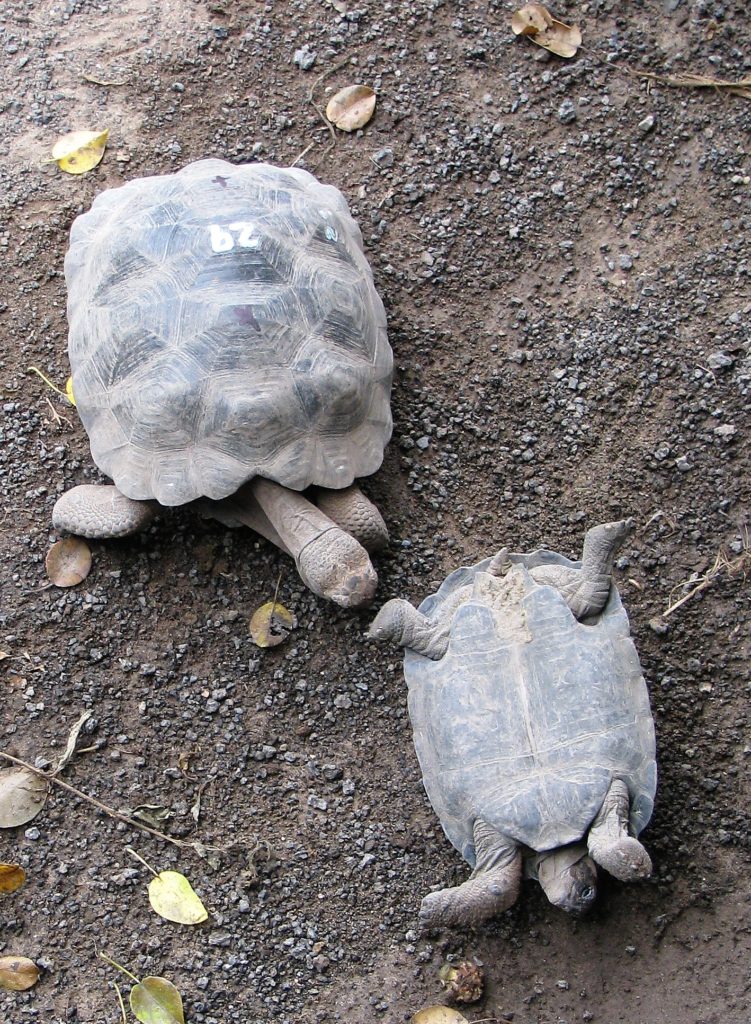
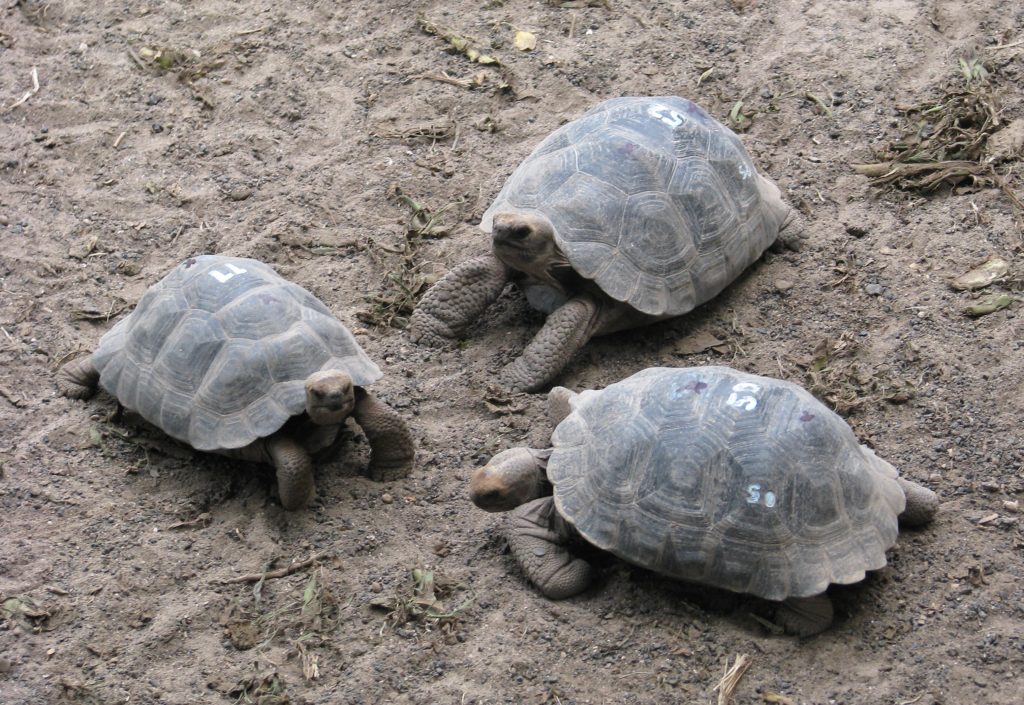
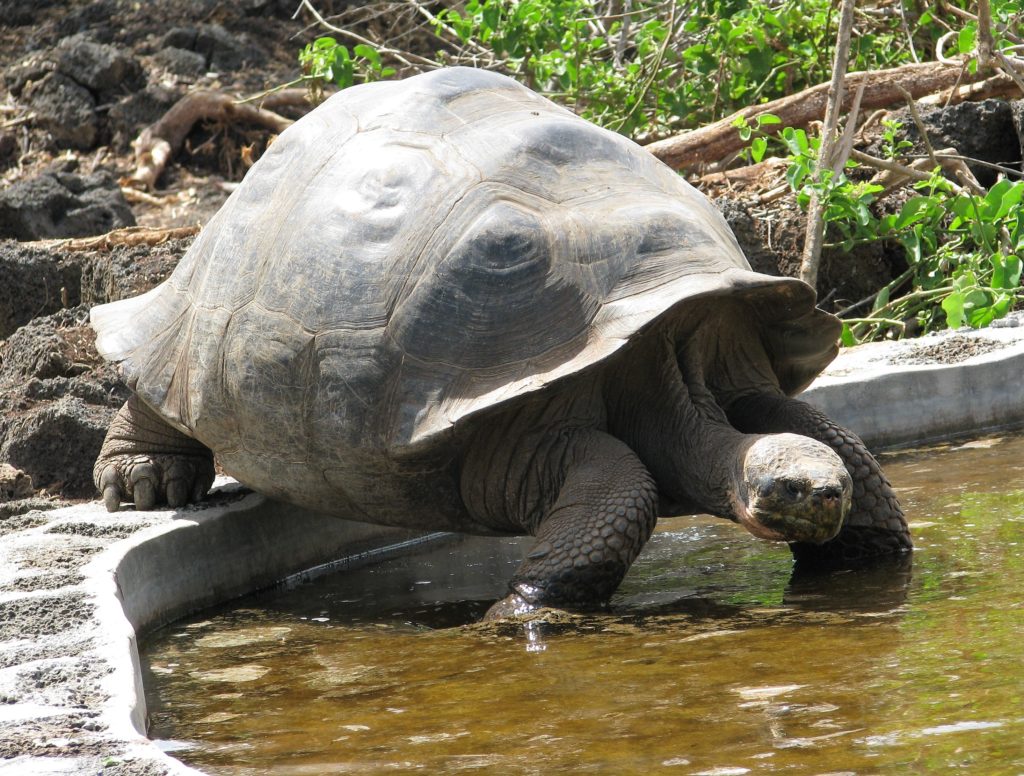
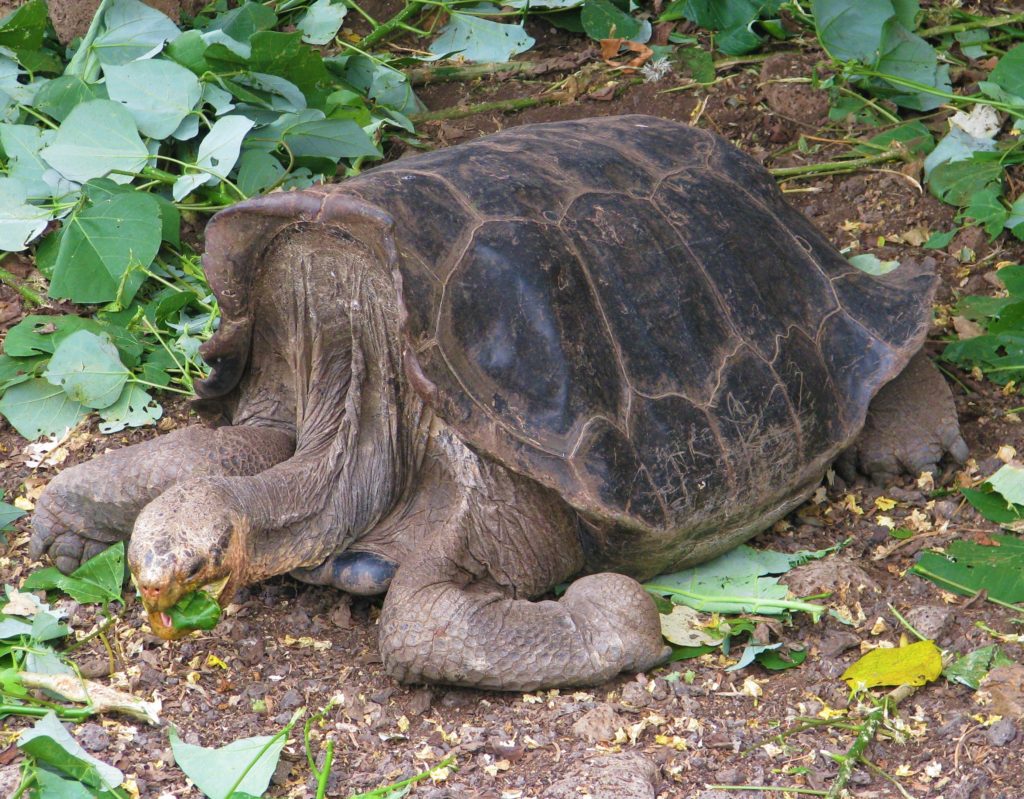
Another highlight of the Research Station? Viewing its most famous resident: Lonesome George. Five different species of tortoises have made their home in the Galapagos islands. Lonesome George was the last known survivor of the Pinta Tortoise species. Scientists moved Lonesome George to the Research Station in 1971, hoping George would sire offspring with a female from a closely related species. Alas, George lived at the Research Station for 40 years with several potential mates, but all of the eggs that resulted from his unions were infertile. On June 24, 2012, Lonesome George was found dead in his corral at a surprisingly young age of about 100 years. . (Giant tortoises often live to be 200 years old) Taxidermists preserved Lonesome George in a pose meant to highlight his unique adaptations: a saddleback shell and long neck which allowed Pinta tortoises to feed on plants higher than ground level. The last of his kind, Lonesome George remains on display in his own climate-controlled exhibit.
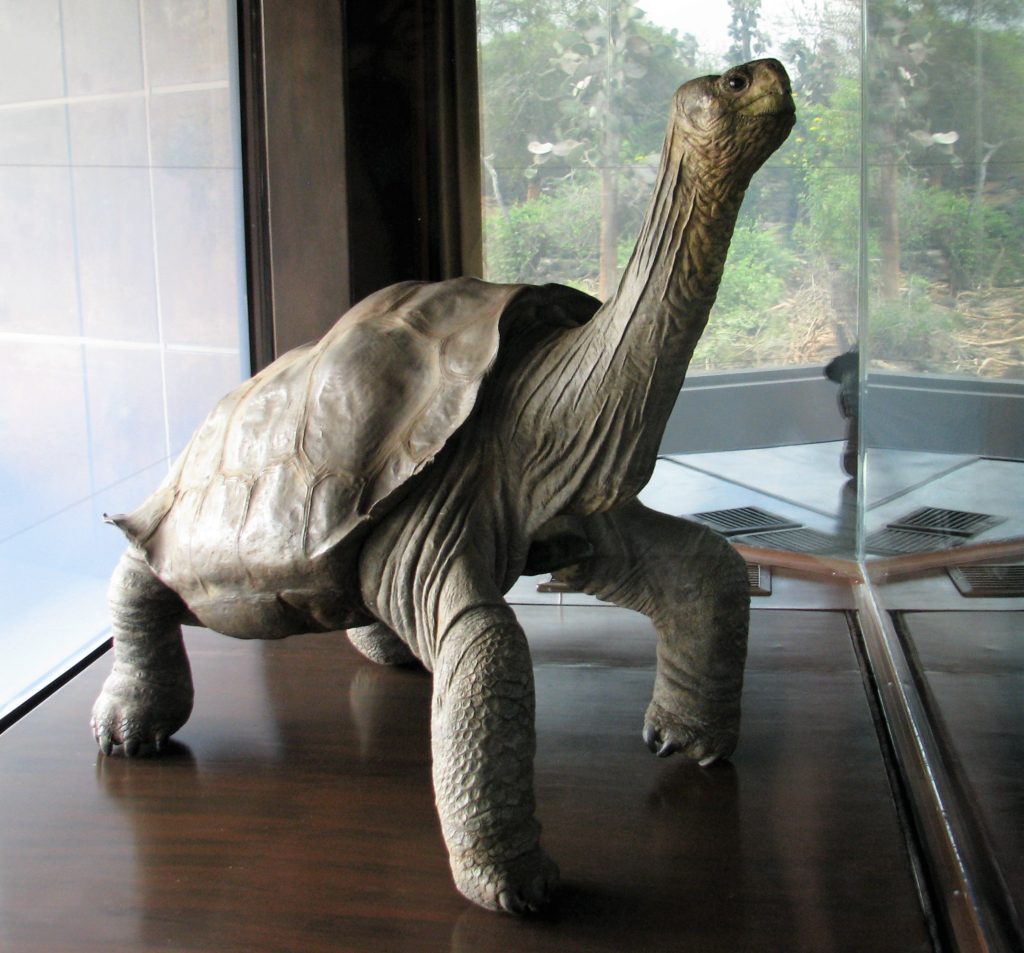
After leaving the Research Station, our afternoon was equally memorable. We hiked into a spectacular beach called Tortuga Bay. The walking path is constructed out of rock and winds through an area of dry vegetation and giant Opuntia cactus. Known as Galapagos Prickly Pear, these specimens look like cactus trees and are an important food source for iguanas, tortoises and cactus finches. I was completely fascinated by the texture and patterns in their trunks.
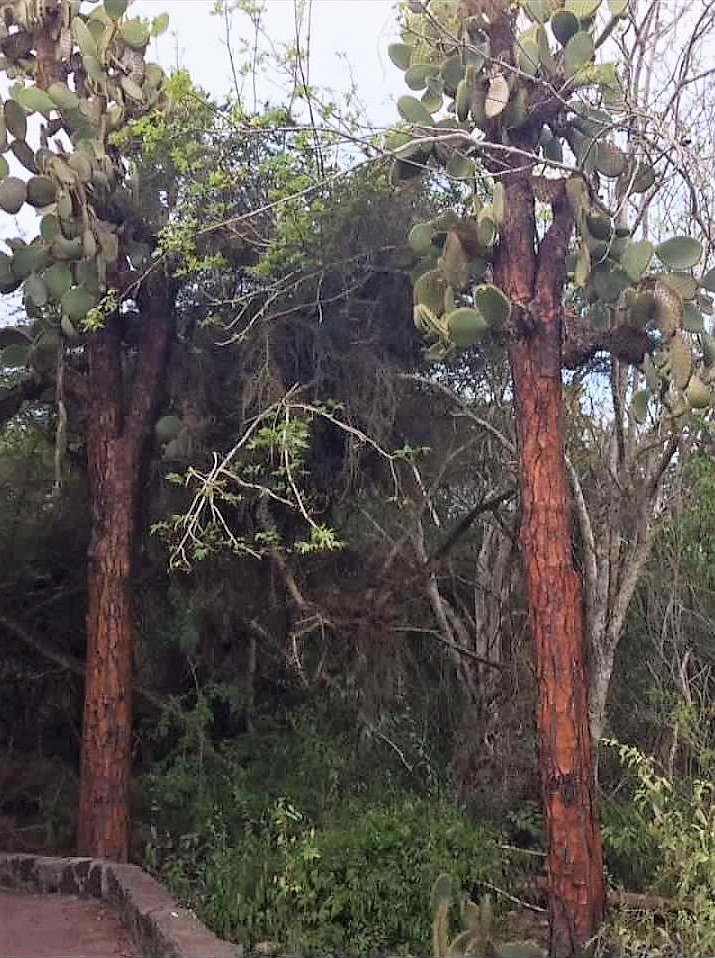
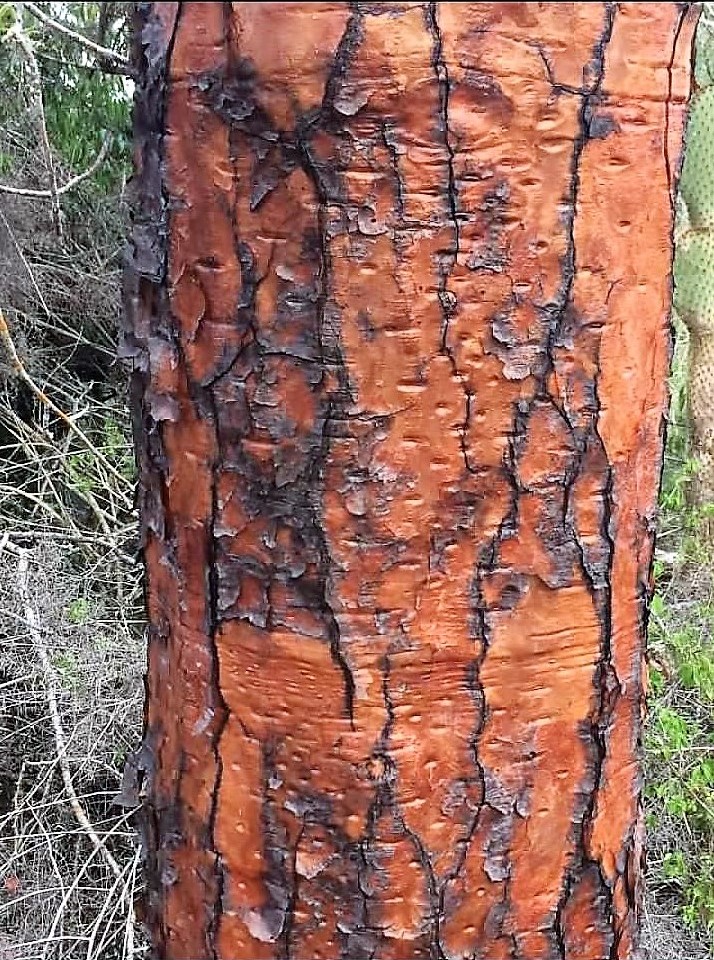

Just over a mile into the walk, we came to a lovely beach called Playa Brava. Swimming is prohibited here due to dangerous currents. Many tourists stop at this point anyway, not realizing the true gem that is a bit further along. We continued hiked for another 15 minutes or so to reach Tortuga Bay. There we found a spectacular white sand beach that stretches across the southern coast of Santa Cruz to the Pacific Ocean. The sea lions basking in the sun completely ignored us. Our tour director adamantly instructed us to remain 6 feet away from any sea lion, even if they approached us. It was all I could do to not to burst out laughing when I heard that. It was a far cry from my Yellowstone Park days when visitors were told to stay at least 25 yards away from all wildlife and 75 yards from bears and wolves. I did have a close-up encounter with a sea lion as I was snorkeling. I felt it brush against my toes, and then it literally swam within inches of my face and blew bubbles at me. I truly think it wanted to play! All in all, an unforgettable experience.
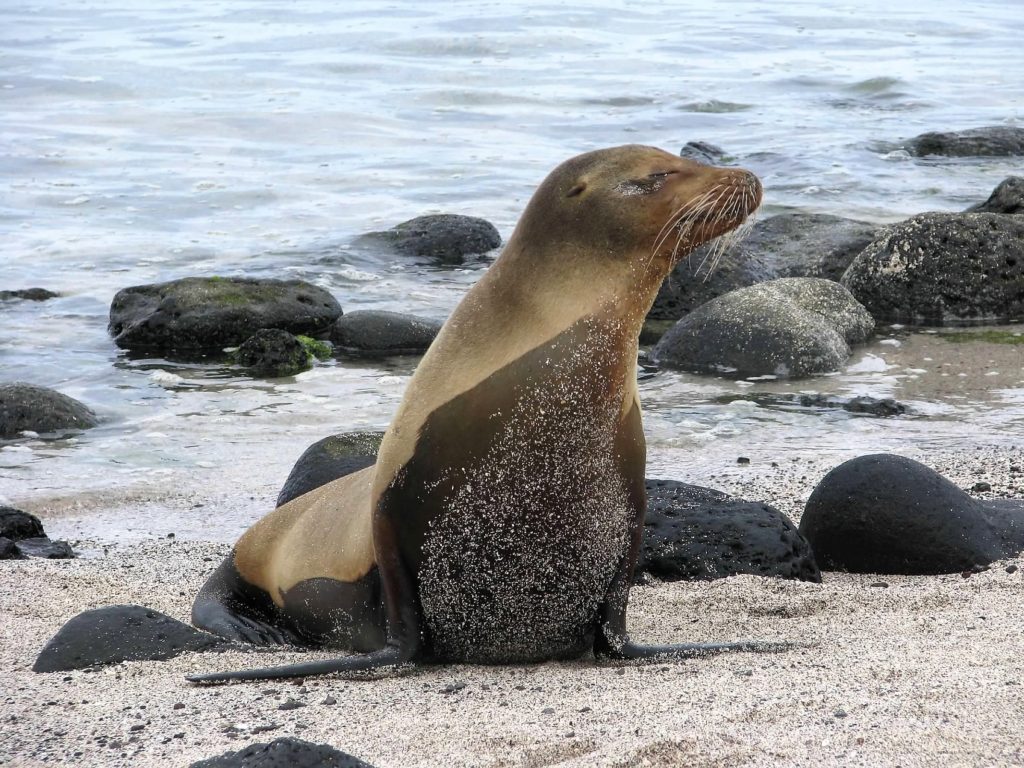
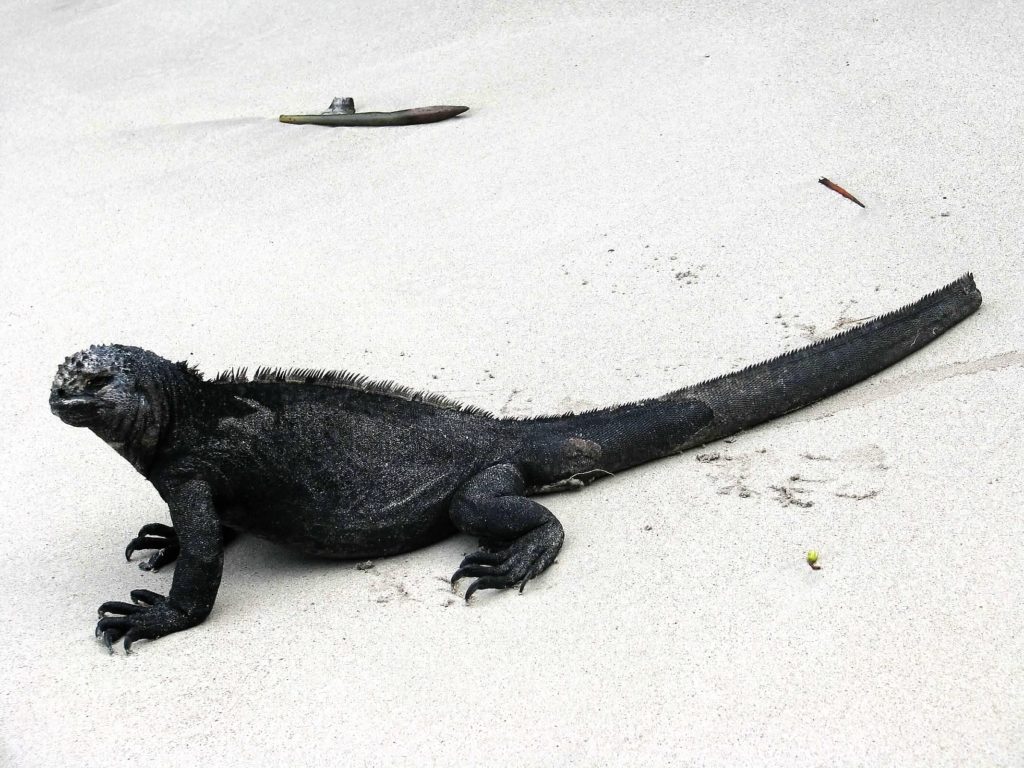
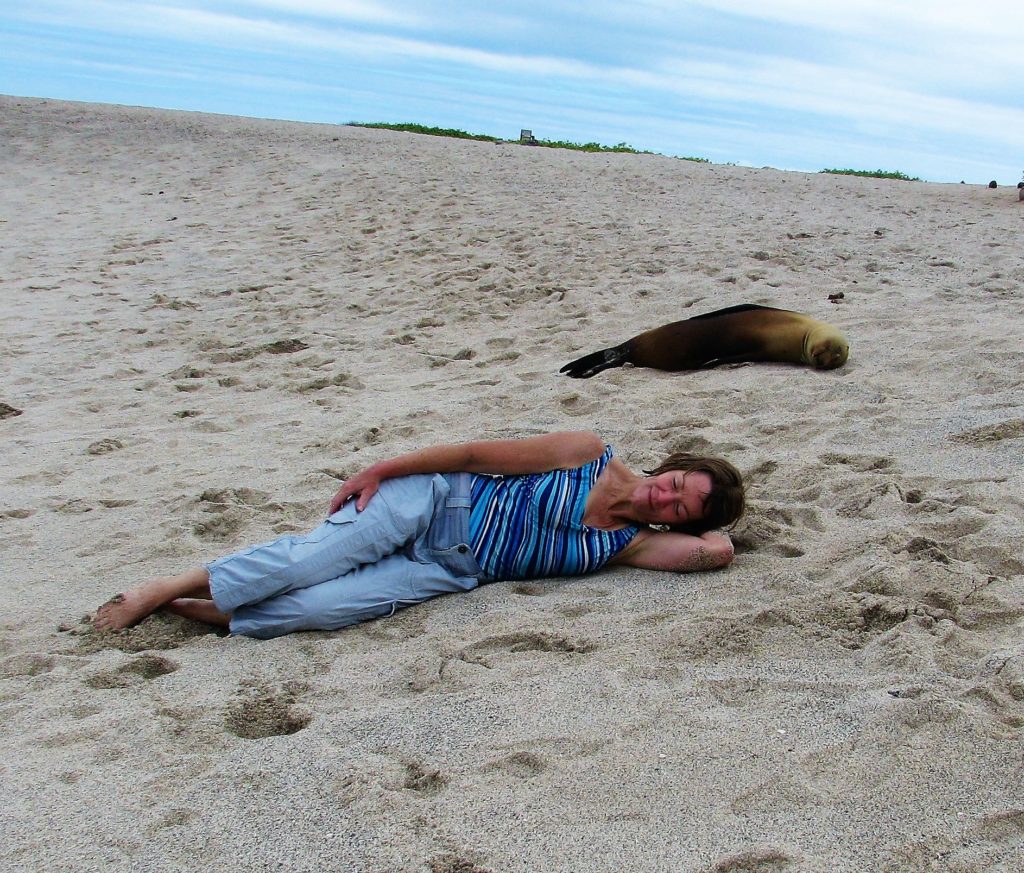
San Cristóbol Island
On Day 6 we traveled to San Cristóbol Island. We were a bit taken aback to see a huge cruise boat in the harbor. San Cristóbol was the most developed of the islands that we visited, with far more tourists. We checked into the Arena Blanca Eco Hotel, and then took a walk around the town. We again were thoroughly impressed by a local church. The Catedral Inmaculada Concepión had gorgeous stain glass windows depicting the native wildlife of the Galapagos.
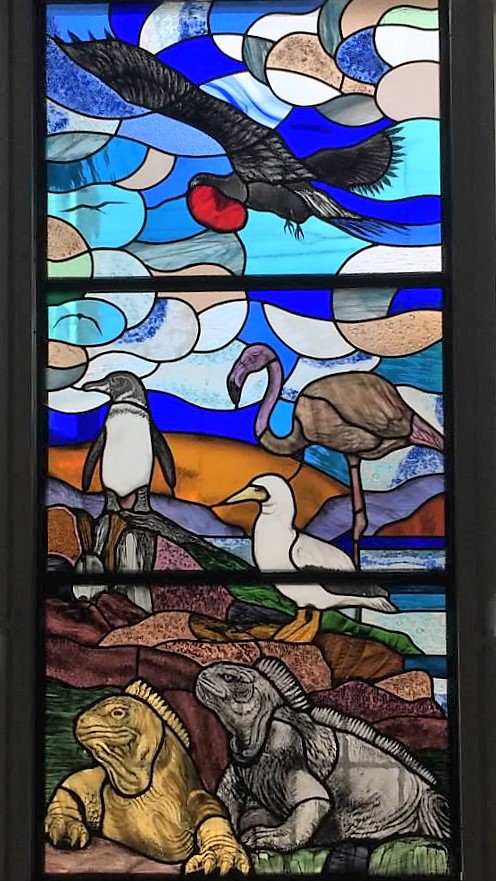
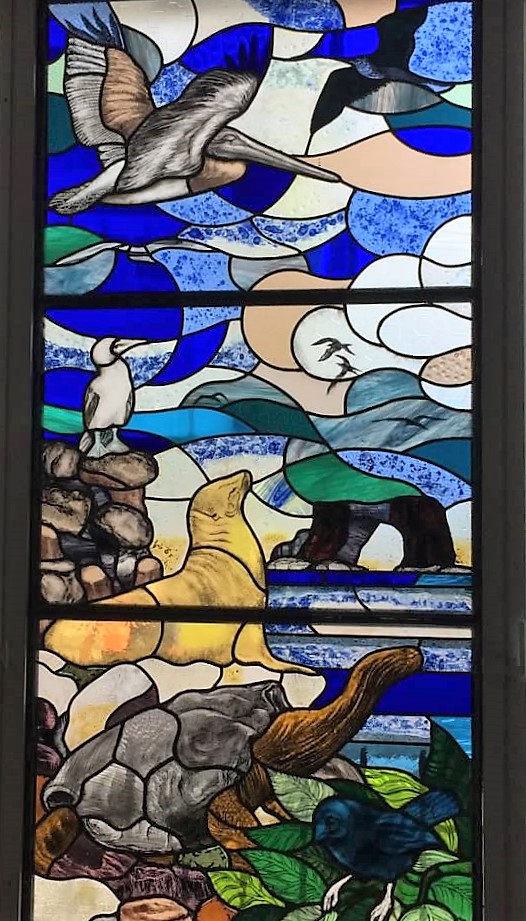
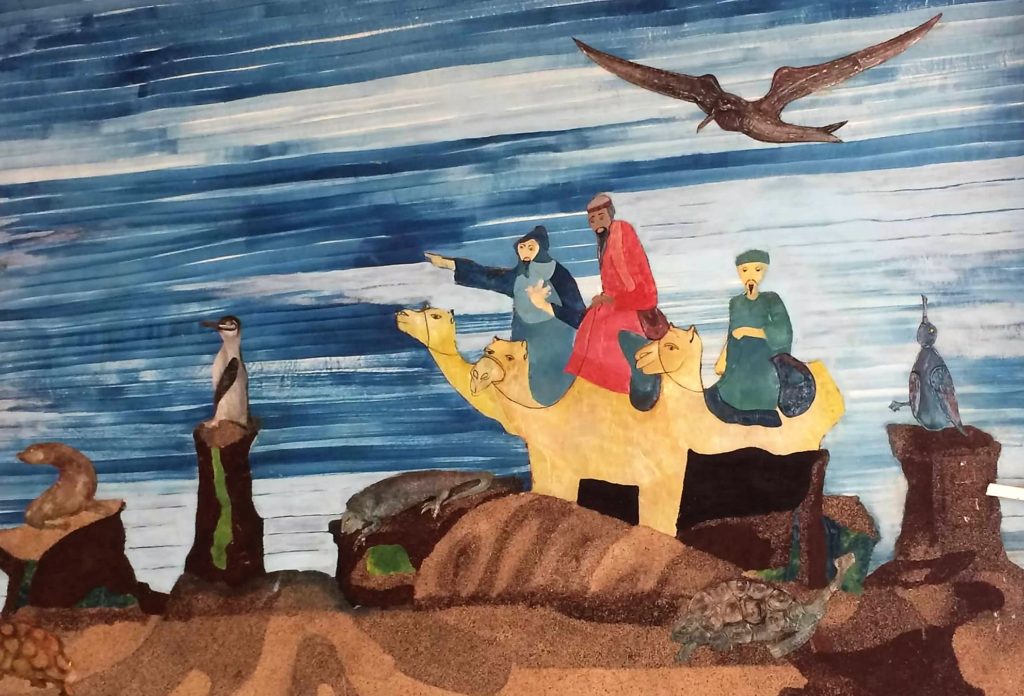
We went on an afternoon hike up Tijeretas Hill . Tijeretes means scissors in Spanish, and it is so named because of the deeply forked tails of the frigatebirds who nest on the cliffs there. When seeing photos of the Galapagos, a common image is of the male frigatebird with its distinctive red throat pouch inflated. While we spotted numerous frigatebirds, the males only inflate their pouches to attract females. As it wasn’t breeding season, we did not get to see this iconic display. I did find a photo of one on the Galapagos Island Blog.
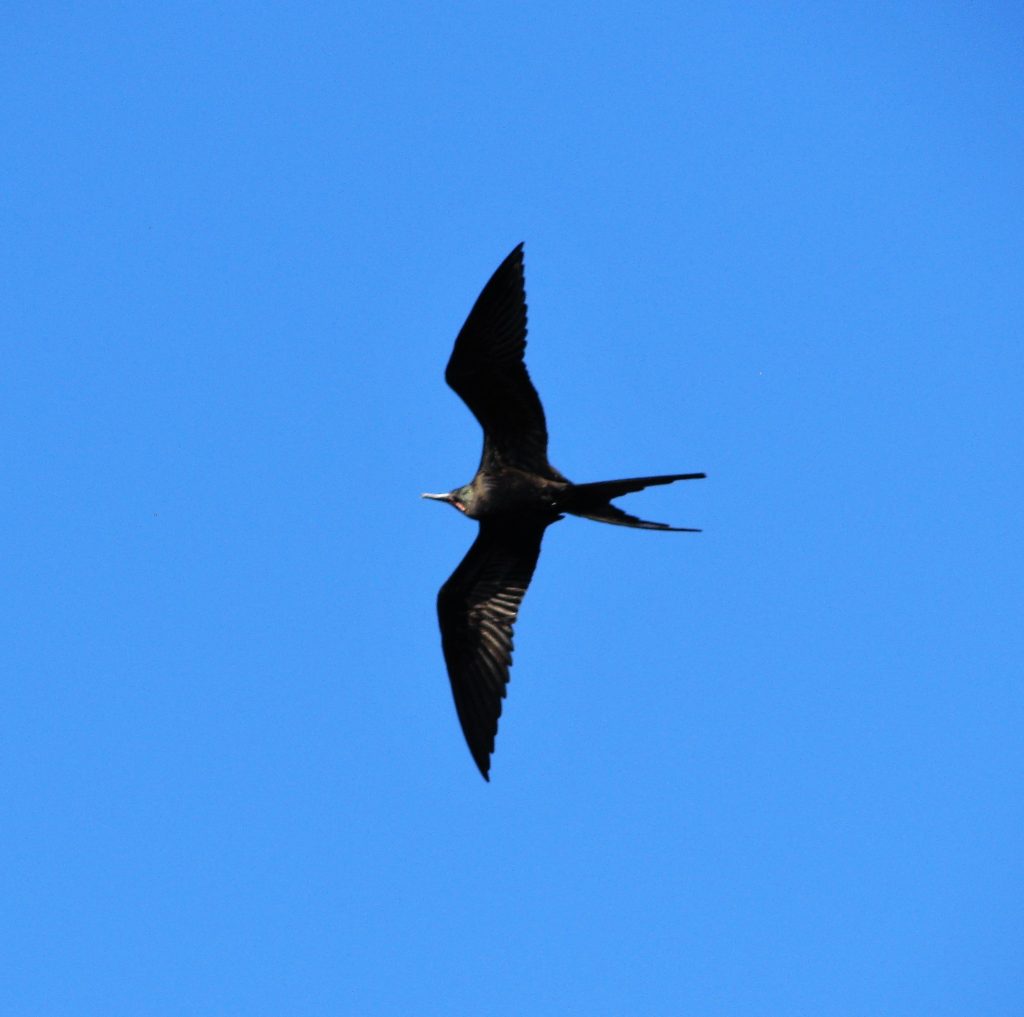
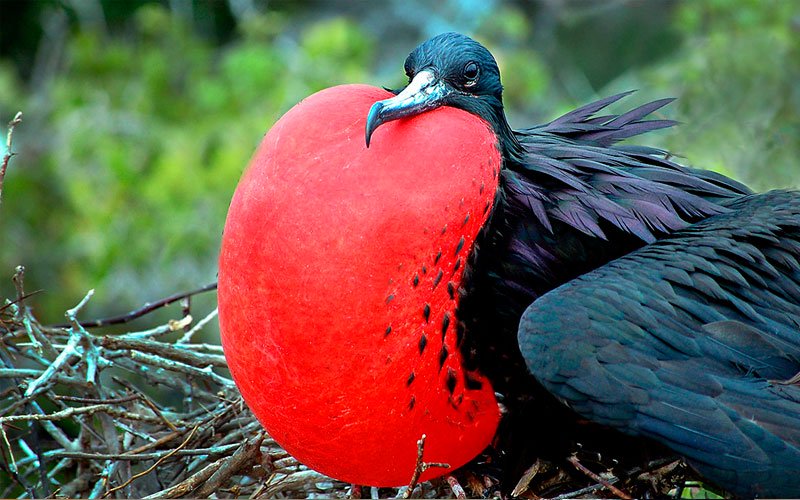
At the base of Tijeretas Hill, there is a small cove that is perfect for snorkeling. There were a number of sea lions in the water who seemed up for frolicking with human visitors. This mama sea lion, however, was not pleased when I took a photo of her nursing her almost fully-grown pup.
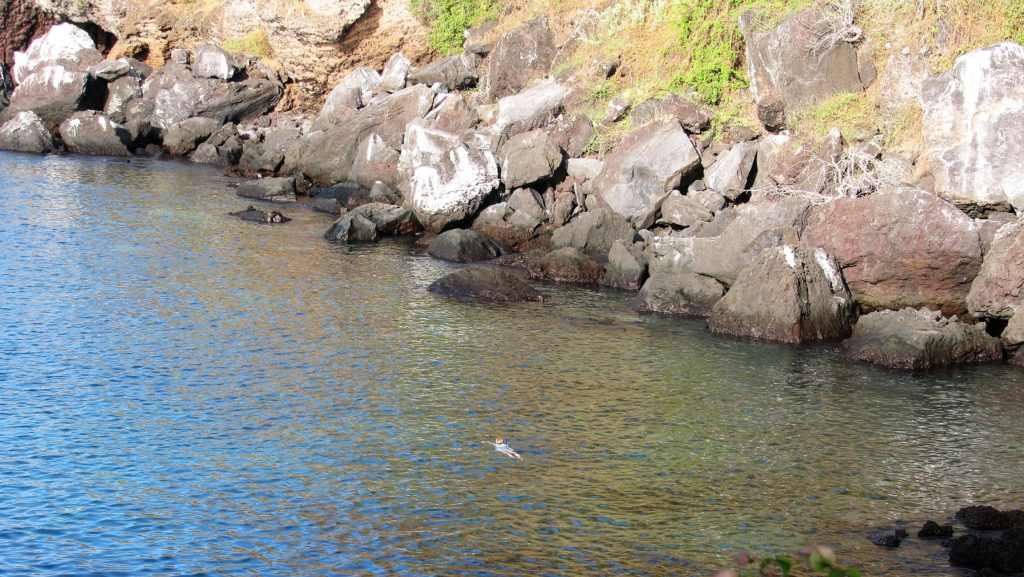
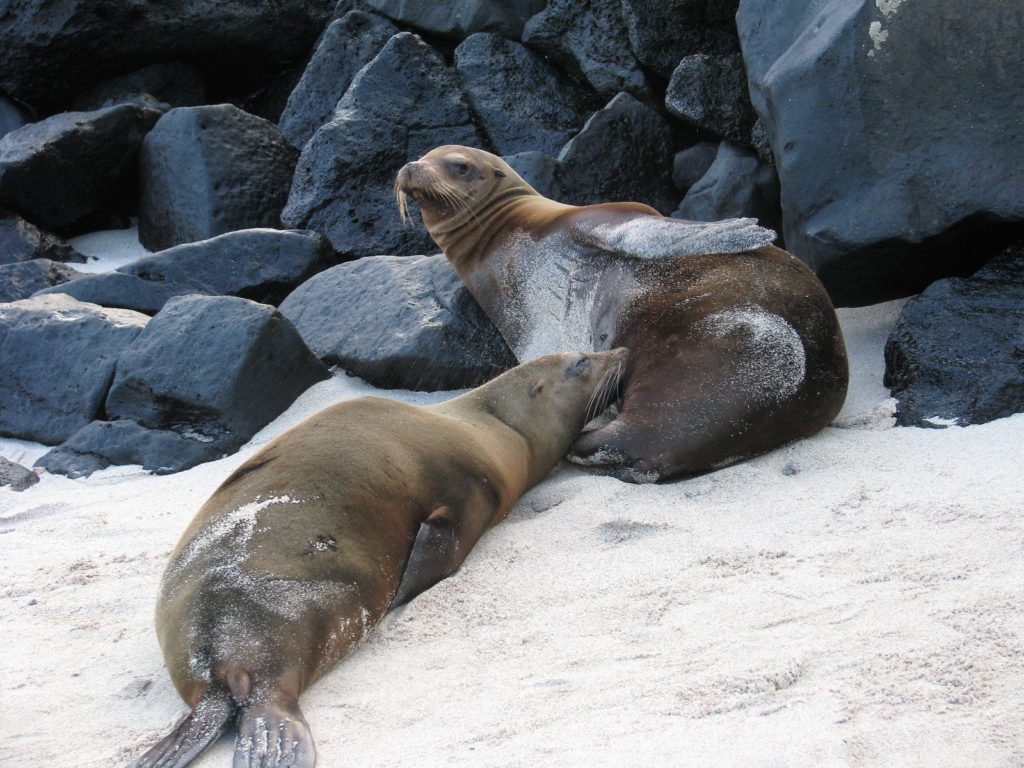
We were in the bus heading back to our hotel just as the sun was setting. Our driver spontaneously made an unscheduled stop at Playa Mann beach so that we could enjoy the sunset on our last day in the Galapagos. The beach was filled with people and sea lions enjoying a beautiful evening. It was a memorable ending to a memorable trip!
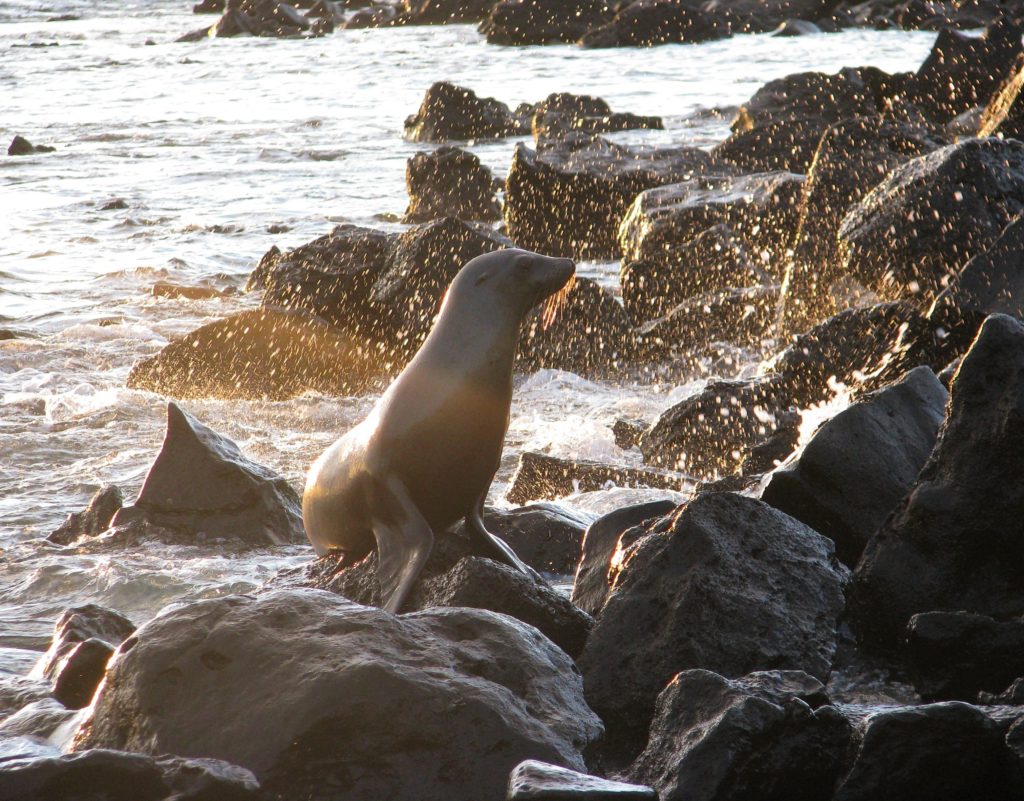
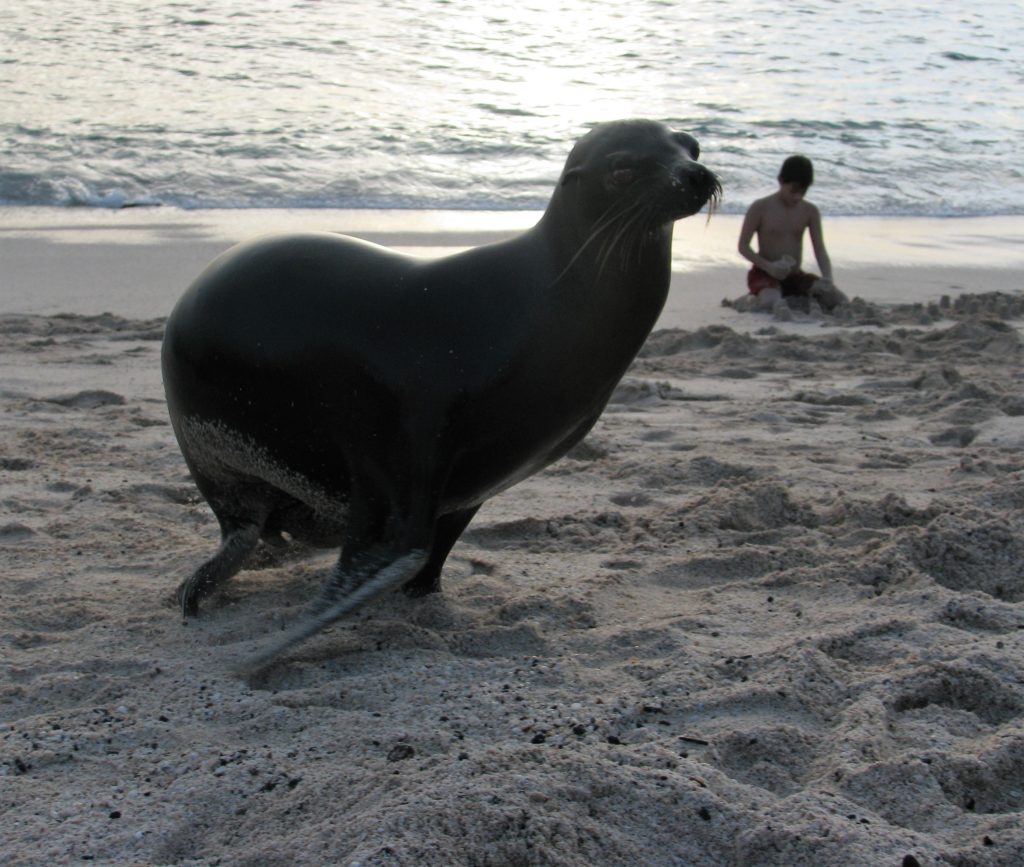
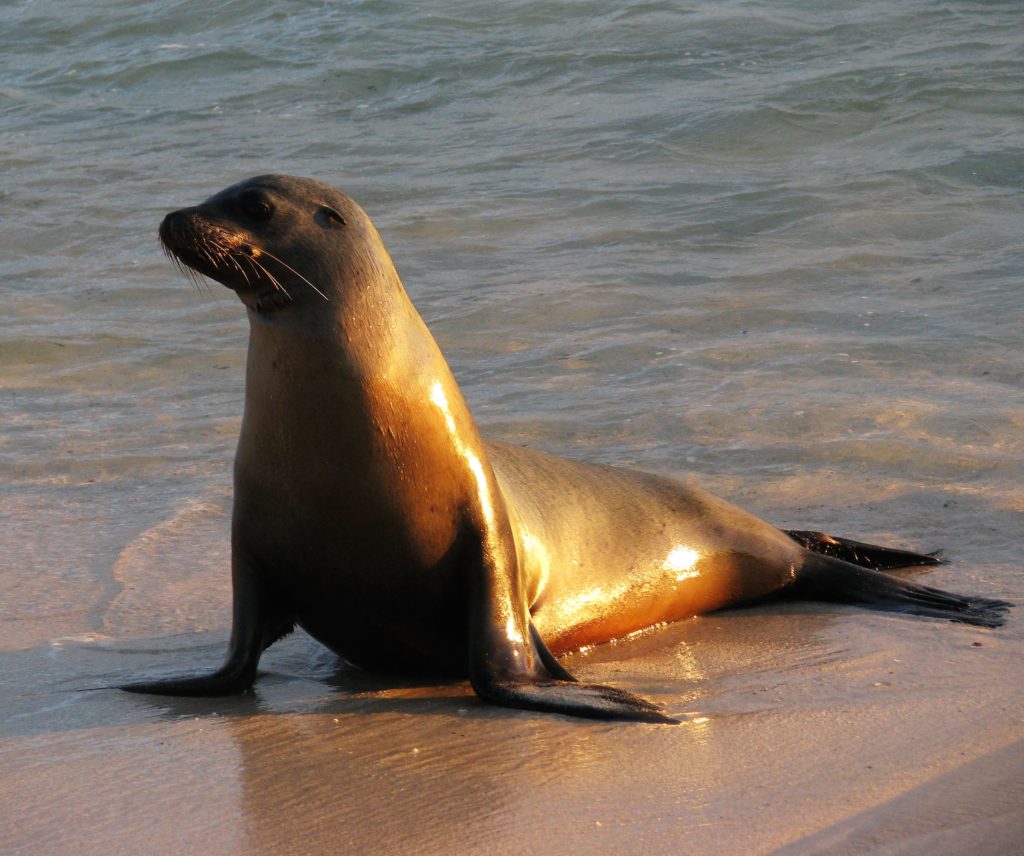
A trip to the Galapagos Islands is a magical experience. It’s a must-do for animal lovers, as it is possible to observe animals in their natural environment that can be seen nowhere else on the planet. Due to protections in place against hunting, most of the Galapagos wildlife have no fear of humans, making it easy to get ridiculously close to them. Just traveling to the islands is expensive, and many of the guided excursions are beyond our budget. David and I were very thankful to have the opportunity to experience this adventure with EF Travel. All of the logistics of planning were handled for us, and we deeply appreciated the vast expertise of our guides. Our one complaint: we were often getting up in the wee hours of the night to travel to our next destination. I’m not sure if this is unique to the Galapagos tour due to the need to take ferries between islands, or if middle of the night awakenings are a hallmark of all EF trips. High School students are not built for early rising. There were often a couple of free hours built into each afternoon, but most of the time David and I ended up going out exploring on our own, as the kids were exhausted. We struggled to convince the kids to come along, as they wanted to nap or just hang out in their hotel rooms. It was hard for us to understand the necessity of trying to get teenagers up and moving before 6:00 am. It was a small price to pay, though, in exchange for a once-in-a-lifetime trip. We came home even more inspired to preserve the unique flora and fauna that we encounter all around the globe.
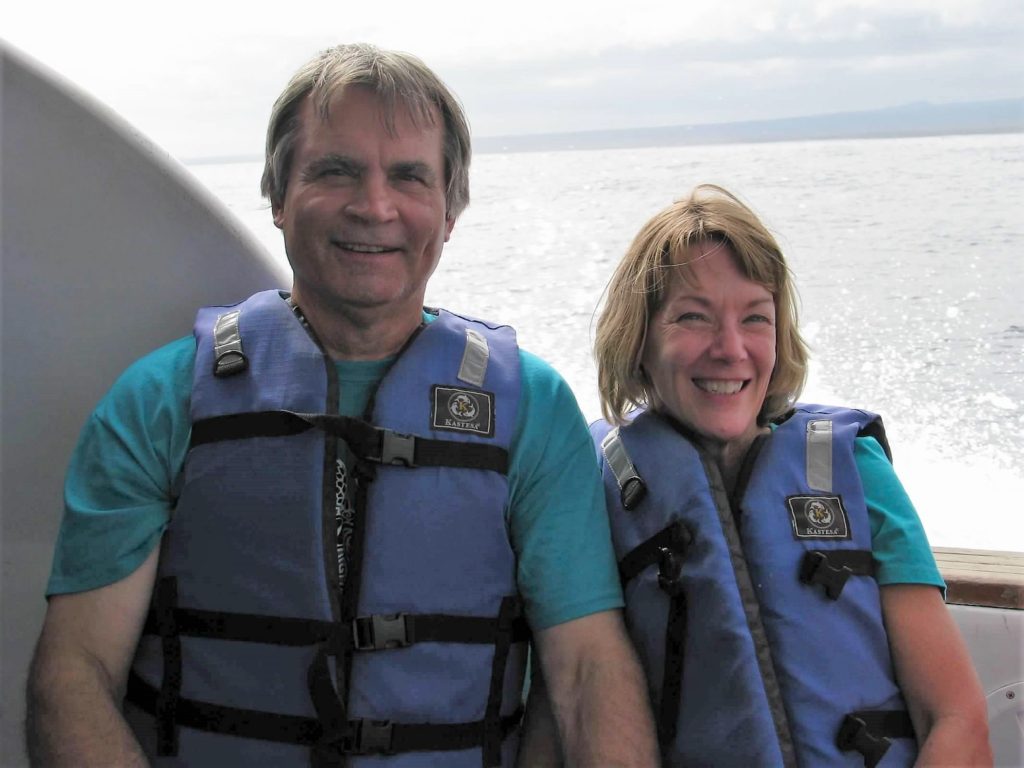
Ditch disposable, Go Resuable
Want to do your part in protecting creatures who live in and around the ocean? Ditch lightweight, single-use plastics that too often find their way into the ocean, polluting the water and potentially harming sea life. Transition to reusable products instead! First item on the list? Plastic straws! A photo of a sea turtle with a plastic straw up its nostril went viral a few years ago, causing me to swear off of plastic straws for good. Look into a good set of reusable metal or bamboo straws. I’ve had mine for several years now and they never need replacing!
Next on the list: no more plastic forks, knives or spoons. Go with reusable silverware. It’s not just for traveling: I bought a set a couple of years ago, and I pack it in my lunch every day when I’m heading off to work. Sticking with the food and beverage theme, check out my favorite Reusable Travel Coffee Cup, and Reusable drinking glasses. Lastly, how do you pack for a meal on the go, or package leftovers? Say goodbye to throw-away sandwich bags. They now make reusable ones!
Let’s all take action to reduce plastic pollution! Seals and sea turtles will thank you!
Planning A Trip? Use Our Favorite Resources!
Accommodations: We recommend using booking.com
Flights: We recommend WayAway
Tours And Experiences: We recommend Viator
Best Clothing And Gear: We recommend REI
These are sites that I use when booking a trip. If you book through my links, I may earn a commission at no extra cost to you. Thanks for supporting On To New Adventures!
We love getting to know our travel destinations, and we are always seeking to engage with the local community and its residents. We recently created a guide describing our favorite ways to connect with local people during our travels.
Enter your name and email address below and our free guide will be on its way to your inbox!

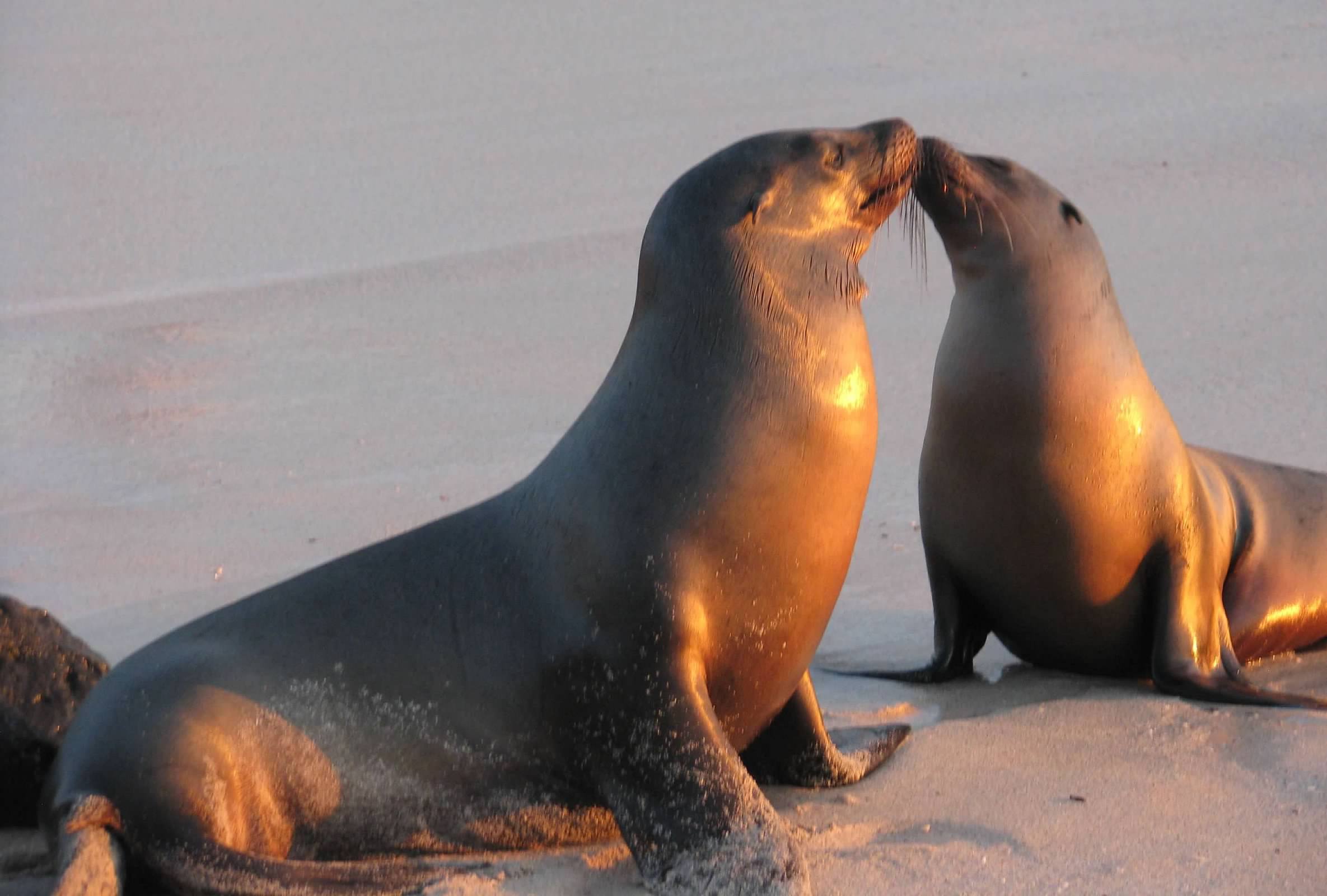
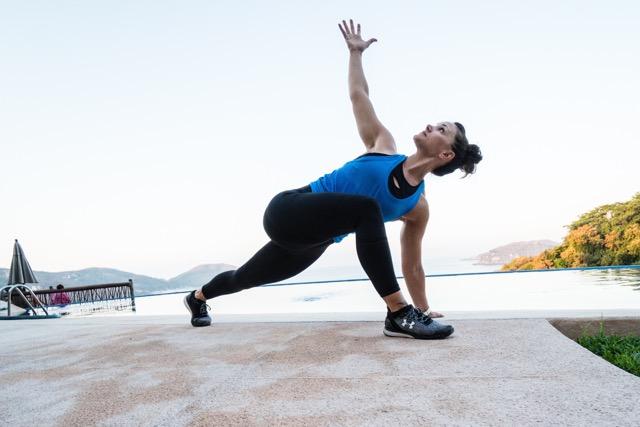
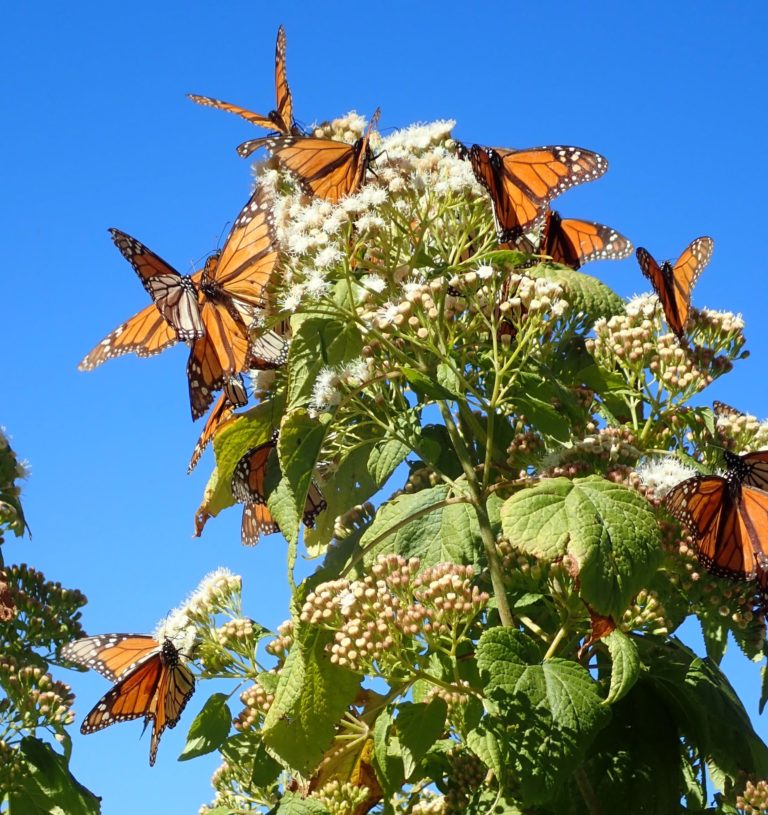
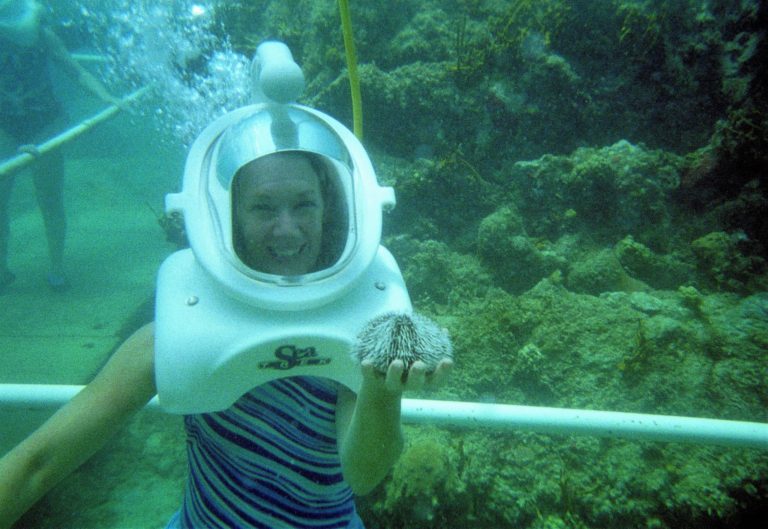
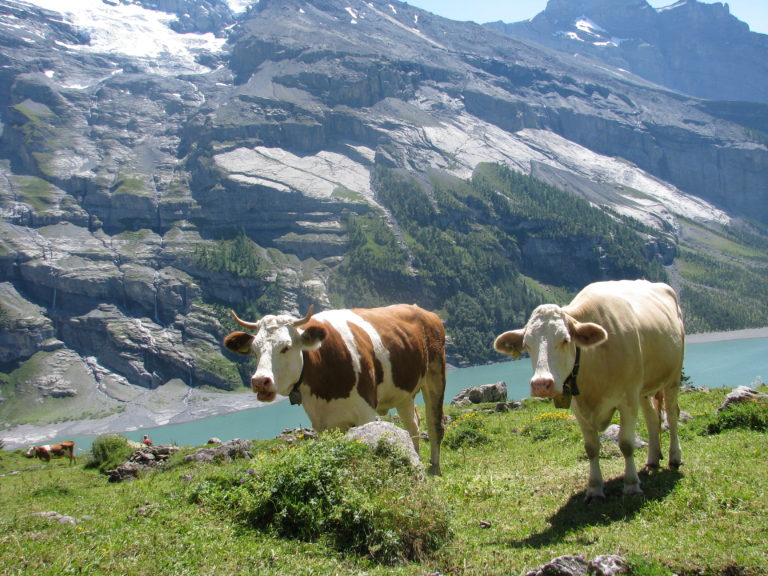
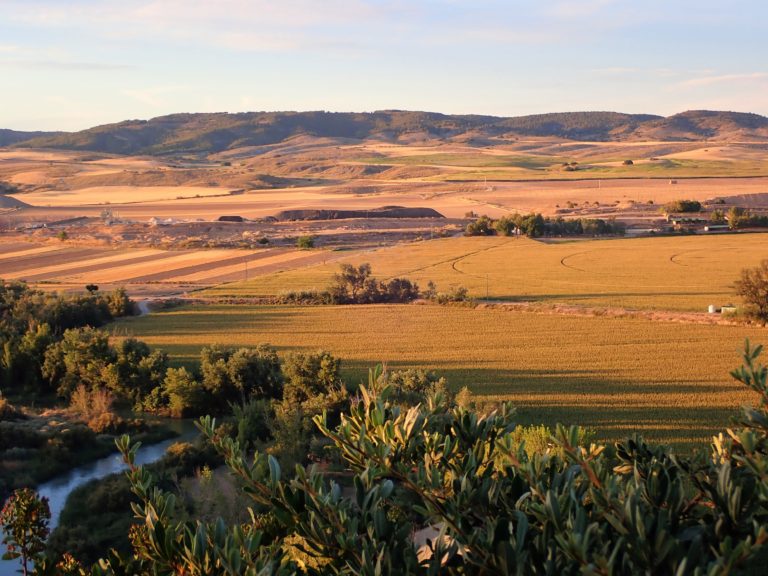
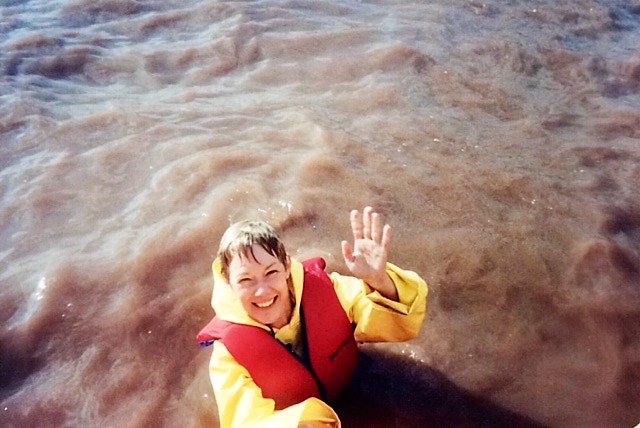
Looks like a great place to visit.
Words can’t really begin to tell you just how great it was.
Sounds like an awesome trip! My kids travelled with the same tour company all through high school, and they really enjoyed it.
Galápagos Islands would be a great trip. Will definitely have to add it to my list!
Ef Travel has so many great tours available, all over the world.
What an amazing experience! All of your pictures are beautiful
Thank you, Monica. Even my photos don’t do it justice.
Beautiful post and pictures! I am si glad you finally got to go… Now I would love to visit too@
Thanks, Holly. The Galapagos truly is a magical place.
That looks like such a wonderful adventure and so neat to see all the wildlife.
Wildlife viewing in the Galapagos in unlike anywhere else on the planet!
Looks like an awesome trip. Thanks for sharing the beautiful pictures. I’d love to visit the Galapagos one day.
I hope there is a Galapagos trip in your future!
Fantastic pictures! I’ve always wanted to go to the Galapagos. I don’t travel much, so I would probably sign up for a tour group.
In regards to the Galapagos, the vast majority of people to sign on with a tour group. The tough part is finding one that you can afford.
What an incredible adventure! The topsy-turvy turtle made me laugh. I’ve wanted to go here since I was a little girl. I hope I manage to actually get here one day. Great informative post.
I hope you make it to the Galapagos one day, Sarah. You would love it!
What an amazing place! I remember when I was younger, my brother used to watch so many things on animal planet and on road trips we would play “I’m thinking of an animal that starts with the letter…” and he would always have the most obscure animals like blue footed boobies and we could never guess them! Haha
Sounds like your bother is a true animal lover!
Fantastic photos! My in-laws went two years ago. They loved it. These pics really bring home the point that there is a whole other world out there waiting for us to explore! Thank you!
Thanks for checking out my blog. Going to the Galapagos really is like going to a whole new world!
What an interesting post. I remember reading about these islands as a child in the National Geographic magazines my parents had. How colorful and fun to actually visit. Thanks for the post.
I think I also first learned about the Galapagos through National Geographic when I was a child. Love that organization!
What an amazing experience and opportunity! Beautiful pics too!!
Thank you so much for taking the time to comment on my post, Debbie.
Looks like an amazing adventure! The teacher’s misfortune definitely paid off for you. I’m sure this is a trip that will be hard to top! Love all the different species you were able to capture in pictures.
You’re right. It’s hard to imagine a trip that could top this one. With the possible exception of an African Safari. That’s been on my bucket list forever!
What a beautiful place! Great photos! What a lucky break to be able to go with the group! Thanks for sharing
I felt sad for the teacher who was unable to go, and for the students as well. We thoroughly enjoyed our trip with the kids, but going with strangers is not the same as going with a beloved teacher. We are grateful that we were asked to step in.
What an amazing experience! This looks like a dream! So many animals!
A dream come true for an animal lover like me.
This looks like such a great time. Your photos are amazing! Definitely keeping this in mind as we start to plan our adventures!
It’s definitely a once-in-a-lifetime experience. I do hope you can visit the Galapagos some day.
This is a dream destination! I can’t go now but love reading about it!
It really was a dream trip. The Galapagos are not easy to get to: I wish everyone could have the chance to go just once!
What an amazing trip! It’s such a beautiful place. Definitely on my bucket list. Thank you for sharing your experience!
I hope you make it to the Galapagos one day, Steph!
What an amazing experience! I am so glad that fell into place for you! Great of you to take those kids! I hope they appreciated you!
We really enjoyed getting to know the kids. While they missed their teacher, I know they were grateful that the trip wasn’t cancelled.
Trip of a lifetime! Thank you for sharing! I loved the pictures! I felt like I was there with you, just wonderful!
Thanks for your support, Erica. I love sharing stories about our adventures.
What an amazing opportunity! This is one location I would love to experience!
It’s a big commitment but so worth it. Fingers crossed for you!
Wow what an awesome experience!!! Thank you for sharing it with us!
Thanks for taking the time to comment. It really was an awesome experience.
What a great place to go and see some unique wildlife. The marine iguanas almost blend in with the rocks. I would’ve been freaked out if I was walking along and then looked down and saw one.
Lol! You would have looked down and seen WAY More than one!
I have priced out trips here as well, only to find them out of my price range. I’m so glad you had the opportunity to go! I love your pictures of the wildlife and of Jesus and Wise Men among the wildlife! Hysterical! Thank you for sharing!
I know. The cost was an issue for us as well. We wouldn’t have been able to do it without EF Travel.
Ohhh one of my DREAM TRIPS! I want to go Scuba Diving with the whale sharks… your photos are so fun!
I hope you can make it happen! You would love Scuba Diving there.
Your wildlife photos are so awesome! I particularly like all the turtle pictures and the blue-footed booby! It sounds like an amazing experience.
Thanks, Jessica. I think the next step in my blogging journey will be to take a photography course. I know there are all kinds of techniques that I am not utilizing.
I love all of the wildlife! I bet that was so cool!
Viewing wildlife is always a big draw for me whenever we are thinking about where we would like to go next. The Galapagos is at the top of the wildlife list!
Wow, that looks like an incredible trip! I love all your beautiful photos!
Thanks, Tiffany. I loved writing this post: it was like re-living our trip!
I loved loved your pictures!!! Both fascinating and fun! I need to remember this! Someday I want to take my children and my foster children on trips for new experiences. Do the students have to be the same age? Should I keep my education certifications up to date?
For EF travel’s school trips, students are close to the same age. For example, all would be in middle school, or all would be in high school. There are other tour groups you can look into that offer family trips. Not sure that it would be critical to keep up your education certificate just for this purpose. I am a teacher, and I know how expensive that becomes with all of the continuing ed that is required. It may be enough to say that you have educational experience or training, even if your certificate is not up to date.
Galapagos is bucketloads! Thank you for sharing this beautiful place. Nature at its finest!
You’re right, Jane. The Galapagos really is nature at its finest.
Such a fantastic opportunity, Linda – I think it just goes to show that when one door closes, another one usually does open! It looks like it was totally worth all those early morning starts and ham and cheese sandwiches. I would love to see that cute little booby with my own eyes. Thanks for sharing your experience!
I am grateful that we did have this fantastic opportunity. I would gladly have eaten ham and cheese sandwiches the entire time in order to make it happen!
What a fun adventure. Your photos are amazing! And some are hilarious!
Thanks, Christina. Many times our trips don’t go exactly according to plan, and David and I always try to view everything with a sense of humor.
We live in Hawaii so I see the Hawaiian turtles all the time. How awesome it would be to see these ones!!!
I loved seeing the sea turtles when we were snorkeling in Hawaii!
Wow what an amazing opportunity for you both! It’s such a unique place to visit. I’d love a chance to explore there someday. I love all your photos. And I loved the tortoise story, about the group helping the young one get right side up. That’s incredible.
It was amazing, Cindy. I wouldn’t have believe the baby tortoise story if I hadn’t seen it myself!
Love love love sea lions!! We see them sometimes here in Ireland. It is so nice to see them in their natural habitat. So nice to see your trip photos 🙂
Maria, I would so love to visit Ireland! Actually, I can’t quite believe we haven’t been there already.
This looks beautiful! I love all the unique animals.
It’s a must-do trip for animal lovers!
Omg your photos are amaaaazing! I didn’t know it was possible to visit the Galapagos Islands (I think I heard it was for biologists and students only?) It’s been on my bucket list forever, but I didn’t know we could actually go!
The Galapagos have been open to travelers for a while now, although logistically it is still easiest to go with a tour group. I never actually thought it would be possible for us to go, either, due to the distance and the cost. Thanks, EF Travel!
This sounds like an amazing trip. All of your photos are gorgeous and really make me want to travel there.
Thank you for the compliment! It truly was an amazing trip.
Your photos are incredible. It sounds like it was the trip of a lifetime.
Thank you, Sarah. We have such wonderful memories.
Always read about this area but never thought about taking a trip there. Looks amazing!
The Galapagos Islands truly are amazing: a high priority trip for animal lovers!
Wonderful pictures. I never considered myself an animal lover until the Galapagos. It’s a trip not to be missed. It’s crazy expensive if you do it as a cruise but you can do it on your own at a fraction of the cost. I found a couple on Trip Advisor who will put together a custom trip for you if you’re willing to do some research. The woman is an American and he is Ecuadorian so he makes all the arrangements at local prices. You make your own arrangements to fly to Ecuador.
Interesting! Of course, we were on a set itinerary with the school group, and often wished we had more time at many of our stops. I will be in touch if we decide to go again: an Ecuadorian making local arrangements sounds perfect!
This is such a great blog post! Thank you for sharing your adventures!
Thanks, Barbara. I know you’re also in northern Michigan: we are fortunate to have such great chocolate shops in our region!